Cover Letter Format Guide: Best Examples & Tips on How to Format

Master the art of first impressions with our comprehensive guide on cover letter formats. Unlock the secrets to crafting a cover letter that stands out and lands you your dream job.
- 30% higher chance of getting a job‡
- 42% higher response rate from recruiters‡
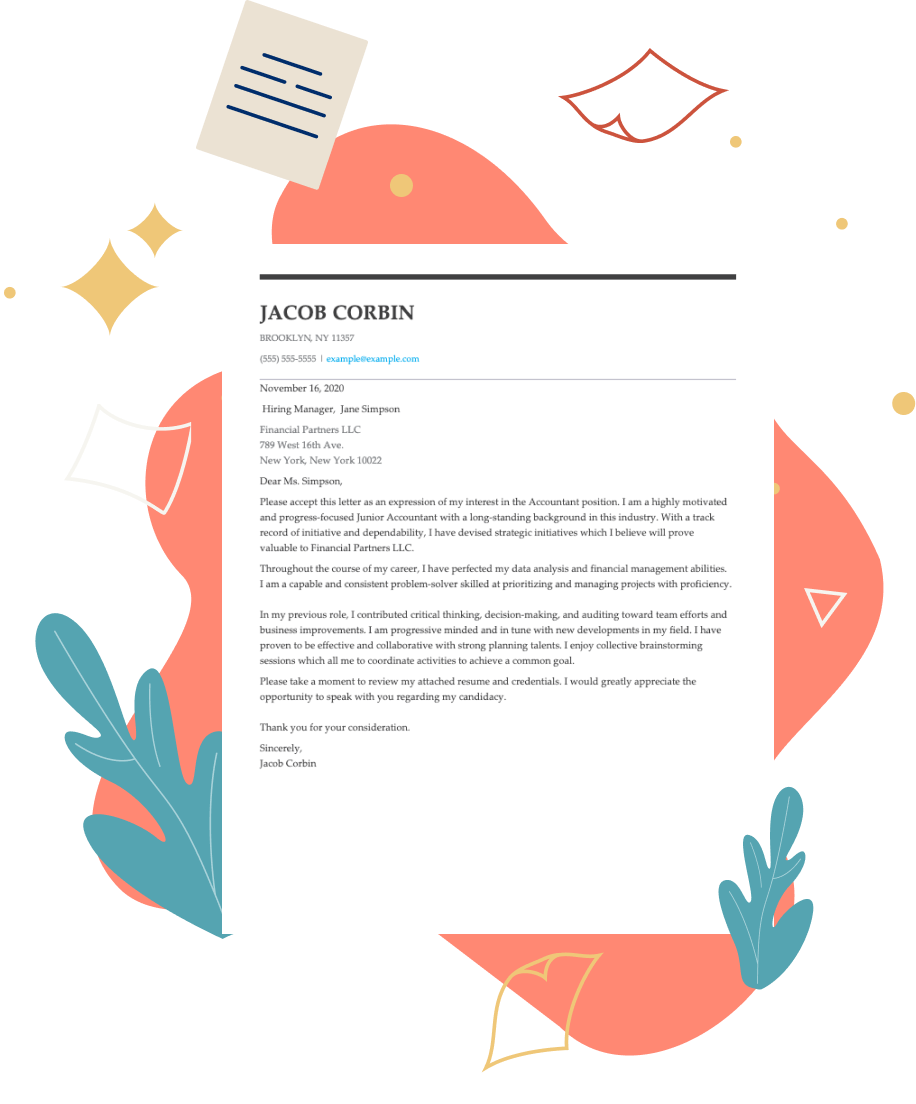
As seen in: * Foot Note
A cover letter is a one-page document, formatted as a business letter, which offers additional insights about yourself not covered in your resume. It’s an opportunity to display your personality, communication skills, and enthusiasm for the role.
A compelling cover letter can distinguish you from other candidates, enhancing your prospects of securing the job. Discover inspiration in our extensive collection of over 200 cover letter examples .

How to format a cover letter
A cover letter is an introduction to your resume. The purpose of a professional cover letter format is to effectively frame your qualifications — including your character and interest in the position — so you can get a chance at a job interview. Your cover letter format has to be perfect if you want employers to read your letter.
Follow this guide to learn how to format a cover letter for a job application correctly. You’ll want to include:
Your contact information
A proper cover letter format begins with a header that contains the job seeker’s contact information. Your contact information should match your resume, and it must be current and professional. Leave the unprofessional email addresses like [email protected] for personal correspondence and have a professional email address like [email protected] ready for job applications.
Contact information in a cover letter format should include:
- Your full name
- City, state and ZIP code
- Phone number
- Email address
- A link to your LinkedIn profile, professional website or portfolio if you have them

Hiring manager’s contact information
Every business letter includes the recipient’s contact information. A cover letter address format looks like this:
January 13, 2022
Leona Evans, Office Manager Climate Solutions Corp Franklin Park, IL 60131 555-555-5555 [email protected]
The job application letter format calls for a professional and formal greeting. Use “Dear” rather than “Hello” or “Hi” in your cover letter salutation, and address the reader by name. Do your best to find the name through the company’s website, LinkedIn or by searching online.
Don’t use formal titles such as “Mr.” “Miss” and “Ms.” unless you know the person’s gender; otherwise, you run the risk of misidentifying the person you’re addressing. Instead, use their full name, like “Dear Bruce Jackson.”
If you can’t find the hiring manager’s name after doing some research, it is acceptable to greet your reader by their title, like “Dear Professor” or “Dear Doctor.” You may also address a department, like “To the Hiring Manager” or “To the Human Resources Department.” Never write a generic greeting like “To Whom It May Concern.”
Opening paragraph
Like all business letters, cover letter formats start with a brief but engaging opening paragraph.
In three to four sentences, grab the hiring manager’s attention by enthusiastically making an opening “pitch” in which you tell them what you can do for them and then back it up. Convey passion for the work and confidence in your abilities — they won’t be able to turn away!
The format of a cover letter introduction follows a basic formula: Brief introduction + why you’re writing + why you are the best person for the job.
This cover letter formatting example shows what that looks like in practice:
I’m a marketing coordinator with five years of experience driving social media campaigns for Company B. I’ve been following Gadgets, Inc. on Instagram since the company was launched last year and was excited to see you have an opening for a social media manager. My consistent track record of conversion-winning campaigns at Company B shows that I can increase your customer base and retention by 25% in my first three months as your social media manager.
Numbers make a big impact! Quantify your achievements and goals in your cover letter format when possible.
Body paragraphs
It’s time to provide details about your skills and job experiences. A good cover letter format will have two or three body paragraphs that connect your top job qualifications with the requirements and responsibilities detailed in the job description.
Take a look at this cover letter format example paragraph to see what we mean:
Over the past two years, I’ve worked as a store manager, engaging with customers and handling inventory distribution for three sister stores. My experience working with transportation brokers, managing database information and maintaining high-level service aligns with what you’re looking for in a logistics manager.
Cover letter body paragraphs are also where you can show you’ve done your homework on the company, underscoring your interest and enthusiasm.
While you’re at it, mention specific aspects of the job and organization that attract you, like this:
I’m impressed with your company’s dedication to improving your products while sticking to environmentally friendly production processes. I share your passion for caring for the environment. To that end, I volunteer weekly at my local chapter of Natural Resources Defense Council, Inc.
The format for cover letter body paragraphs is three to four sentences each, so make every word count. Use action verbs throughout to pack a punch!
Closing paragraph with a call to action
How do you close a cover letter? As they say in show business, “leave them wanting more.”
The format for a cover letter closing is one paragraph with three to four short sentences that confidently recap why you’re the best candidate for the role. It’s also a good idea to thank the reader for their time, reiterate genuine interest in the job, and invite the hiring manager to follow up with you for an interview.
For example:
Thank you for considering my application. I’m certain my talent for contract negotiations, eye for design and aptitude for organization make me the event planner you’ve been looking for. I’d be honored to show you why Atlanta Magazine named me “Planner of the Year” in 2018 and 2019. Please contact me by phone or email at your earliest convenience to discuss how we can work together to achieve your event planning goals this year and beyond.
The cover letter standard format for a signoff is a simple formal phrase, followed by a comma, then a space, then the writer’s name.
Wrap up your cover letter with phrases like “Best regards,” “Regards,” “Respectfully,” or “Sincerely,” for your signoff.
Don’t use informal terms like “Thanks!” Take care,” “Cheers!” or “Have a nice day!”
Best regards,

Best cover letter format
The best way to format a cover letter is with a professional cover letter template .
Download one of our expertly designed templates for free to create a cover letter from scratch, or use a template with our Cover Letter Builder and let us do the work for you!
Our cover letter templates are sure to organize your qualifications with the correct formatting and they meet the latest applicant tracking system (ATS) requirements, making it a breeze to write a professional cover letter in minutes.
In addition, our builder offers the following features:

Job-specific phrases and skills:
No matter the job you’re applying for, we give you the right words and relevant skills you can incorporate with just one click.

Easy customization:
Write a cover letter for every job application and save as many versions of it as you need.

Step-by-step guidance:
Get expert advice at every step to help you present your best self and get the job.

Multiple download formats:
Save and export your cover letter as a PDF, DOCX or plain text.
How to format a cover letter for an email
An email cover letter format differs slightly from a standard cover letter format. If the job description requires you to send your letter in the body of an email, then use these tips to organize your email message perfectly:
Create a professional subject line:
If the employer doesn’t give you specific instructions for submitting a cover letter for a job application, put the title of the position you’re interested in and your name in the subject line.

Start with the salutation:
You don’t need to include the employer’s mailing address when you format a cover letter for an email message, so jump straight to writing a formal greeting (e.g., “Dear Mrs. Jones”).

Include your contact information at the bottom:
A professional format for a cover letter places your contact information underneath your signoff, in this order:
- City and state of residence
- Job profile link (if available)
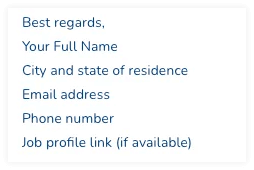
Your email cover letter message should look like this:
Learn more about how to format a cover letter for an email in our in-depth guide.
Free cover letter format examples
Get inspiration from a cover letter sample format. We have an extensive library of cover letter layouts for most jobs, industries, career levels and circumstances, so you’re sure to find the best cover letter format for your needs.
Modern cover letter format example
This format for a cover letter presents a sleek, readable appearance — perfect for situations where you want to present yourself as an up-to-date, cutting-edge employee.
Cover letter professional format example
You can’t go wrong with this professional cover letter format for jobs that emphasize reliability, efficiency and productivity.
Creative sample cover letter format
Make your cover letter layout stand out from the crowd with this design, utilizing elegant colors and a stylish monogram design.
Simple job application cover letter format example
Even simple can look good as long as you organize your letter in a streamlined format, as this cover letter structure demonstrates.
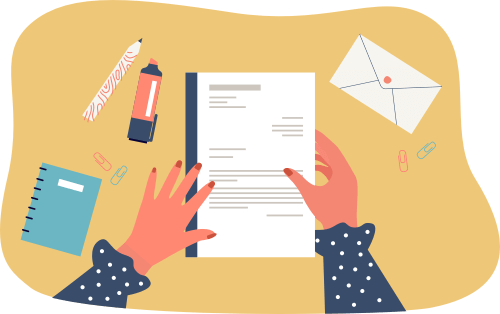
Professional cover letter format tips
Having a professional cover letter format isn’t just about filling in each section of a cover letter. A good-looking document is in the details, including margins, fonts and spacing.. Follow these rules of thumb to ensure your cover letter looks great.
Our samples show you how to format a cover letter so the side, top and bottom margins are one inch all the way around.
A proper cover letter format uses standard fonts such as Times New Roman, Helvetica or Arial, in 12-point size. Unusual fonts can confuse applicant tracking systems (ATS) that employers use to scan cover letters and resumes.
As our cover letter examples demonstrate, your cover letter layout should be single-spaced, with a double space between paragraphs.
Your text should be left-justified throughout your cover letter. The one exception to this might be your cover letter header , depending on the template you’re using.
File format
Unless the employer specifies the preferred cover letter format to save your file in, it’s best to send it as a PDF or Word document.
Our Cover Letter Builder, you can save your letter in both formats and plain text.
Check out our 5-Star Reviews
Key takeaways.
Here’s a quick recap so you can write the perfect cover letter and get an interview .
- A cover letter format follows a straightforward business letter format.
- Use 1-inch margins with a common font like Helvetica in 12-point size for maximum legibility.
- Align the date and hiring manager’s address at the top left under the cover letter heading.
- Start with an attention-grabbing opening paragraph that shows interest in the position and confidence that you are the best fit.
- There are two or three body paragraphs in a cover letter format. Use them to elaborate on why you’re interested in the job and the skills you can bring.
- Emphasize professional achievements and use numbers to make an impact.
- Don’t be afraid to invite the hiring manager to contact you for an interview in your cover letter closing.
- Your letter should be one page and 500 words long.
- A cover letter template makes creating a professional cover letter easy. Use one with our Cover Letter Builder, and we will format a cover letter for you.
A cover letter format is a framework that organizes information in a cover letter. The best format for most cover letters is the same as a standard one-page business letter. It should contain the following sections: a header with the applicant and hiring manager’s contact information, a salutation, an opening paragraph, one or two short body paragraphs, a closing paragraph and a signoff.
Read up on what to include in a cover letter for additional guidance and advice from career experts.
The format for cover letters written in the body of an email is slightly different than those written in a document. When writing a cover letter in an email, remember the following:
- You can omit a header if you send your cover letter as an email.
- Sign your cover letter with your name, followed by your city and state of residence, email address, phone number and job profile link (if available).
- Check the job description to see if the employer wants you to use a specific subject line. If not, write the subject line with the job title, such as “Application for Teacher’s Assistant role” followed by the job number if it has one.
The general rule for standard cover letter formats is one page. One page is enough to convey your qualifications and interest in the job without overwhelming the reader with too much information. Explore our guide on basic cover letters for additional guidance creating a succinct yet compelling letter.
When writing a cover letter, it’s important to be concise and to the point. Use short paragraphs and bullet points to highlight your relevant skills and experience, and avoid repeating information that is already in your resume.
Keep in mind that employers may receive many applications for a single job posting, so you want to make sure that your cover letter is easy to read and makes a strong impression. By keeping your cover letter to one page, you can ensure that it is well-written and focused and demonstrates your suitability for the job.
If you don’t have any work experience, you can still write a great cover letter! To do this, focus on the transferable and hard skills you can apply to the job and explain how you would do so. Tell stories about how you used those skills in personal, school or volunteer experiences.
For example, if you have strong interpersonal skills and have previously used them to achieve something or support someone, write about it. Or, if you are applying for a job that requires good writing skills, explain how you have used this skill to achieve something.
Some of the most common mistakes when writing a cover letter are:
- Not using the correct format.
- Writing lengthy letters.
- Using informal salutations and signoffs.
- Rehashing their resumes.
- Forgetting to include a call to action.
- Not proofreading.
Check out the best AI cover letter generators and use one to make an error-free cover letter in minutes.
A cover letter should be in a professional format with a clear and concise structure. Here are some tips for formatting your cover letter:
- Use a standard font: Choose a standard font such as Times New Roman or Arial, and use a font size of 10-12 points.
- Use a professional tone: Your cover letter should be written in a professional tone, with correct grammar and punctuation.
- Use a clear structure: Your cover letter should have a clear structure, with a header, introduction, body paragraphs, and conclusion.
- Address the hiring manager: If possible, address the hiring manager by name in your opening paragraph.
- Use keywords: Use keywords from the job description to tailor your cover letter to the role you are applying for.
- Keep it concise: Your cover letter should be no more than one page in length, and you should aim to keep your paragraphs short and to the point.
- Proofread your letter: Before submitting your cover letter, make sure to proofread it carefully for spelling and grammatical errors and to ensure that it is well-written and professional.
Overall, your cover letter should be well-structured, professional, and easy to read, with a clear focus on your skills and qualifications for the position.
When formatting a cover letter for an internship, it’s important to follow a professional format and tone while highlighting your relevant skills and experience.
Use a standard business letter format, with your contact information, the date and the employer’s contact information at the top. Address the employer by name, if possible. If you don’t know the employer’s name, use a professional greeting such as “Dear Internship Coordinator” or “Dear Hiring Manager.”
In the opening paragraph, introduce yourself and explain why you are writing the letter. Mention the specific internship you are applying for and why you are interested in the position. In the second paragraph, highlight your relevant skills and experience, and explain how they make you a good fit for the internship. In the third paragraph, explain why you are interested in the company and what you admire about its mission, values, or culture.
In the closing paragraph, thank the employer for considering your application and express your interest in discussing the internship further. Include your contact information and a call to action, such as “I look forward to hearing from you soon.”
If you don’t know the name of the person to whom you are addressing your cover letter, there are a few options. Here are some tips on how to write and format a cover letter when you don’t know who to address it to:
- Do some research: Try to find the name of the hiring manager or recruiter by doing some research online or by calling the company’s HR department. If you’re applying to a specific job posting, the contact information may be listed in the job description.
- Use a generic but professional greeting: If you don’t know the name of the person you’re addressing, you can use a generic greeting such as “Dear Hiring Manager,” “Dear Recruiting Team,” or “Dear Sir/Madam.” This is a polite and professional way to address your letter when you don’t have a specific name.
- Use a departmental address: If you can’t find a specific name, you can address your cover letter to a department rather than an individual. For example, you could address it to “Dear Marketing Department” or “Dear Human Resources Team.”
Keep it professional: Regardless of how you address your cover letter, make sure to keep your tone professional. In the body of your cover letter, focus on your qualifications and how they make you a good fit for the position.
When applying for a job online, it’s important to format your cover letter in a way that is easy to read and upload to the company’s website or application portal. Use a standard business letter format with a professional font such as Times New Roman or Arial.
Save your cover letter as a PDF file to ensure that the formatting remains intact and the document is easy to read. Use a clear structure with a header, introduction, body paragraphs and conclusion. Before submitting your cover letter, proofread it carefully for spelling and grammatical errors and to ensure that it is well-written and professional.
If you are writing the cover letter directly into the company’s application portal, you should still include a heading, professional greeting and signoff in addition to the body of your letter. Check that the body paragraphs are separated and that the letter is well-structured and easy to read.
More cover letter formatting tips
Our career center has plenty of additional tips and guides to help you get the best cover letter format.

5 Qualities That Are Part of Every Successful Cover Letter

By Kellie Hanna, CPRW
February 17, 2023

How to Write the Perfect Cover Letter After Maternity Leave
By Nilda Melissa Diaz, CPRW

Answers: Why Should We Hire You?
April 11, 2024

How to Write a Cover Letter for a Job That Doesn’t Exist…Yet
January 18, 2023

8 Ways To Incorporate Volunteer Work Into Your Cover Letter
March 22, 2023

2024’s Leading AI Cover Letter Generators: Review and Comparison

By Elizabeth Muenzen, CPRW
February 26, 2024
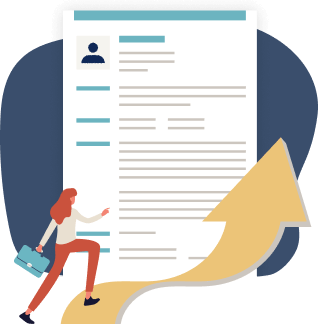
Just three easy steps
- Select a template from our library of professional designs
- Build your cover letter with our industry-specific bullet points
- Download your cover letter and send!
Download your free cover letter template!
Please fill in the required fileds with *
I have read and agree to MyPerfectResume's privacy policy and Terms and Conditions

Congratulations!
You've taken a big leap forward in your job search by choosing a cover letter template from MyPerfectResume.
Advertisement
‡ Results derived from a study responded by 1000 participants of which 287 created a resume online.
*The names and logos of the companies referred to above are all trademarks of their respective holders. Unless specifically stated otherwise, such references are not intended to imply any affiliation or association with MyPerfectResume.
Purdue Online Writing Lab Purdue OWL® College of Liberal Arts
What do I include in my cover letter heading?

Welcome to the Purdue OWL
This page is brought to you by the OWL at Purdue University. When printing this page, you must include the entire legal notice.
Copyright ©1995-2018 by The Writing Lab & The OWL at Purdue and Purdue University. All rights reserved. This material may not be published, reproduced, broadcast, rewritten, or redistributed without permission. Use of this site constitutes acceptance of our terms and conditions of fair use.
"Writing Your Cover Letter" is a series of short documents that walks you through the creation of a cover letter. Here you can see the information in the "Quick Tips for Cover Letters" and "Preparing to Write a Cover Letter" pages put to use. This page guides you through adapting your experiences to the content in your cover letter and its different sections.
The heading provides your contact information, the date you are writing, and the address of the company to which you are applying.
For your contact information, you will want to include the following:
- The address where you can be reached ( if you live at college, will it be more accessible to include the local address or your permanent address? )
- Phone number
- Fax number (if applicable)
- E-mail address
Then, you will skip a line and write the full date ( month, day, year ). Follow this by skipping a space and writing the contact information for the person to whom you are writing:
- Name of the specific person
- Title of that person (if available)
- Address of the company
Craig M. Leroix 2987 W. Taylor Dr. Portland, OR 45720 890-372-1262 [email protected]
February 2, 2005
Amy Kincaid, Human Resource Director Western Electric, Inc. 387 Collier Lane Atlanta, Georgia 30051
Job seekers at Purdue University may find value in the Purdue career Wiki here .
The following are additional Purdue OWL resources to help you write your cover letter:
- Cover Letter Workshop- Formatting and Organization
- Example Employment Documents
- Cover Letters 1: Quick Tips
- Cover Letters 2: Preparing to Write a Cover Letter
- Cover Letter Presentation
- Job Search Documents for Working Class Positions
How to Write a Cover Letter Header

by Heather O'Neill, CPRW | Career Expert
Last Updated: May 16, 2023
Table of contents
What to include in a cover letter header
6 cover letter header examples, how to format your cover letter header, cover letter header faq.
The first step in learning how to format a cover letter is to start at the top: the header for a cover letter. Here, we outline everything you need to know about cover letter headers, including:
- What information belongs in a cover letter header.
- Sample cover letter headers for you to review.
- How to format your cover letter header.
For more cover letter header examples, review our library of cover letter samples . Search by job title or industry to explore professionally written content and cover letter templates for the role you seek.
Related Guides & Tips
- How to End a Cover Letter
- How to Write a Cover Letter in 2024
- Purpose of a Cover Letter
- When To Use Bullet Points In A Cover Letter
There are six main components that go in your cover letter header. They are:
- Your full name
- Your home city and state
- Phone number
- Email address
- LinkedIn profile (if you have one)
- Other relevant links, such as a portfolio or social media links (if applicable)

Contemporary 2

Executive 2

Contemporary 5

Formatting your cover letter header is simple if you follow the following rules:
Use a larger font for your resume header than for the rest of your cover letter to make it stand out. The body of your letter should use a font size between 10-12 points, so make your cover letter header between 14-20 points, depending on the length of your letter. (Your cover letter should always fit on a single page.)
Feel free to use color for the header of your cover letter, but make sure it’s a color that is easy to read both on paper and on a computer screen. Darker colors often work best since lighter colors, like yellow, can sometimes be too light to read.
Choose an easy-to-read font in your cover letter header. Avoid script or fonts like comic sans, which could be difficult for a recruiter to read and could confuse an applicant tracking system (ATS).
If you want to skip formatting altogether, consider using our Cover Letter Builder , which offers an array of cover letter templates to choose from — all of which are perfectly formatted.
Is letterhead the same as a cover letter header?
No. Letterhead is a printed heading at the top of stationery. It contains the sender’s name and, if the stationary is being used for a company’s correspondence, a logo and address. Cover letter headers, on the other hand, are most often sent digitally and always contain the applicant’s name, location and contact information so that recruiters can contact them for a job interview.
How do you title a cover letter?
The best way to title your cover letter is to use your name, the job title you seek and the type of file format you have saved the letter in. For example, you might title your cover letter, “anne_dennis_cashier.jpg” or “patricia_kim_accountant.doc.”
What is the layout of a cover letter?
The layout of a cover letter contains six basic elements: the header, the salutation or greeting, the introduction paragraph, the body of the letter, the closing paragraph and the signoff. These sections should always appear in the same order on every letter you write. For more information on the layout of a cover letter, visit our How to Write a Cover Letter page .
Was this information helpful? Let us know!
Heather O'Neill, CPRW
Heather is the Content Strategy Manager for Resume Now and a Certified Professional Resume Writer (CPRW) with more than ten years of experience writing about job search and career topics. She is based in San Francisco.
Read more articles by Heather O'Neill, CPRW
Related content
What Your Resume Should Look Like in 2024 [+ Example]
A good-looking resume will always use simple fonts and an easy...
Resume Summary Examples: 50+ Summaries for Any Job
A professional summary statement, sometimes called a career pr...
150+ Action Verbs, Synonyms and Adjectives for Your Resume
Resume action words describe the tasks you perform on the job....
Esthetician Resume: Examples, Templates & Tips for 2024
Make a esthetician resume that gets interviews. Use our writin...
Web Developer Resume: Examples, Templates & Tips for ...
Make a web developer resume that gets interviews. Use our writ...
Machine Operator Resume: Examples + Templates for 2024
Get inspired with our machine operator resume examples, templa...
- Career Blog
Cover Letter Heading: 10 Best Examples for 2024

A cover letter is an essential document that accompanies a resume when applying for a job. It serves as an introduction to the candidate and provides an opportunity to showcase their skills and qualifications. While the resume lists the candidate’s experience, education, and achievements, a cover letter allows the candidate to explain why they are the best fit for a particular position.
A well-crafted cover letter can make a difference in a hiring manager’s decision to invite a candidate for an interview. A cover letter allows the candidate to personalize their application and demonstrate their interest in the company and position they are applying for. It is an opportunity to highlight specific skills and experiences that make the candidate a strong fit for the job.
Purpose of Cover Letter Heading
The heading of a cover letter is the first thing that the hiring manager will see. It should include the candidate’s contact information, the date, and the recipient’s name and address. The purpose of the heading is to make the cover letter look professional and informative.
The Basics of a Cover Letter Heading
When it comes to writing a cover letter, one of the crucial parts to pay attention to is the heading. In this section, we will discuss the definition of a cover letter heading, where to place it, what should be included, and tips for creating a strong cover letter heading.
A. Definition of Cover Letter Heading
The cover letter heading is the section that appears at the top of the cover letter. It contains important information that introduces the letter and provides context about the applicant. Typically, the heading includes the applicant’s name, address, phone number, and email address. The employer also expects the date they received the letter to be present.
B. Where to Place Cover Letter Heading
The cover letter heading should be placed at the beginning of the cover letter, right at the top of the page. It should appear aligned to the left-hand margin of the document.

C. What Should be Included in Cover Letter Heading
As previously mentioned, the cover letter heading should include essential personal information such as the applicant’s name, address, phone number, and email address. If the letter is being sent via email, including the applicant’s HTML email signature (if they have one) may be an additional, more professional touch. Additionally, it’s important to include the date the letter was written, as well as the employer or hiring manager’s name and address.
D. Tips for Creating a Strong Cover Letter Heading
A strong cover letter heading should be easy to read and contain all the necessary information. Here are some tips to guide you:
Use a legible font: choose a font that’s easy to read, popular examples include Arial or Times New Roman.
Keep it brief: the cover letter heading doesn’t need to be too long. Just include the essentials and keep it concise.
Use appropriate spacing: ensure there’s enough spacing between each line that will make the heading clear, easy to read, and navigate.
Add a personal touch: consider adding a professional-looking personal logo or design to your header that visually elevates the heading and makes it stand out.
Proofread: Finally, review and confirm that all information is correct and up-to-date, this helps avoid any errors that might distract attention from what should be communicated in the letter.
By following these tips and best practices, you can make sure that your cover letter heading stands out from the rest and provides the employer with the information they need. This will increase your chances of getting the hiring manager’s attention and landing the job you want.
Best Examples of Cover Letter Heading
One of the most important aspects of a cover letter is the heading, as it sets the tone for the entire document. Here are 10 examples of the best cover letter headings:
Example 1: Traditional Heading
A traditional heading includes your name, contact information, and the date of the application. It’s a classic and professional option that never goes out of style.
Example 2: Modern Heading
A modern heading can incorporate a bold font, unique design, or color to grab the reader’s attention. It shows off your creativity and attention to detail.
Example 3: Minimalist Heading
A minimalist heading uses simple and clean lines to convey a sense of sophistication and professionalism. It’s a great option for industries like finance or law.

Example 4: Creative Heading
A creative heading incorporates elements like graphics or images to showcase your personality and stand out from the competition. It can work well in artistic or design-related fields.
Example 5: Unique Heading
A unique heading can include a catchy tagline, quote, or reference to the job you’re applying for. It captures the reader’s attention and makes a memorable impression.
Example 6: Professional Heading
A professional heading includes your name, job title, and contact information. It’s straightforward and highlights your experience and qualifications.
Example 7: Personalized Heading
A personalized heading references the company or position you’re applying for, and shows that you’ve done your research and know what the company values.
Example 8: Industry-Specific Heading
An industry-specific heading includes relevant keywords and phrases that align with the industry or job you’re applying for. This shows that you have a strong understanding of the field.
Example 9: Keyword-Optimized Heading
A keyword-optimized heading uses specific keywords and phrases from the job posting to ensure that your application doesn’t get overlooked by applicant tracking systems.
Example 10: Eye-catching Heading
An eye-catching heading uses a bold font, color, or unique design to catch the reader’s attention and make a lasting impression. It’s a great option for creative fields.
Your cover letter heading should be a reflection of your personal style and the job you’re applying for. Use these 10 examples as a starting point to create a heading that stands out and sets you apart from the competition.
How to Choose the Best Cover Letter Heading for Your Application
When it comes to crafting a cover letter heading that will catch a potential employer’s eye, there are several factors to consider. These include the job requirements and company culture, your personal brand and industry, and the purpose and tone of your cover letter. By tailoring your heading to the job and employer, you can increase your chances of standing out among other applicants.
A. Analyze the Job Requirements and Company Culture
Before crafting your cover letter heading, carefully analyze the job requirements and company culture. Look for keywords and phrases that are frequently used in the job description, as well as any specific company values or mission statements mentioned on the company website. This will give you a better sense of what the employer is looking for in a candidate and how you can position yourself as a strong fit for the role.
B. Consider Your Personal Brand and Industry
Your personal brand and industry should also play a role in choosing the best cover letter heading. If you work in a more creative industry, for example, you may want to use a more colorful and unique heading that reflects your personality and design skills. On the other hand, if you work in a more traditional or conservative industry, a more straightforward and professional heading may be more appropriate.
C. Determine the Purpose and Tone of Your Cover Letter
The purpose and tone of your cover letter should also guide your choice of heading. If you are applying for a job with a specific company, you may want to use the company name in your heading to show your interest and attention to detail. If you are hoping to convey a more personal or passionate tone, you may want to use a heading that highlights your motivation for applying to the job.
D. Tailor Your Heading to the Job and Employer
Ultimately, the key to choosing the best cover letter heading is to tailor it to the job and employer. This means taking into account the job requirements, company culture, your personal brand and industry, and the purpose and tone of your cover letter. By doing so, you can create a heading that stands out from the competition and captures the attention of your potential employer.
Common Mistakes to Avoid in Cover Letter Heading
Your cover letter heading is the first thing that recruiters and hiring managers see when they open your application. It’s essential to make a great first impression, and avoid the following mistakes:
A. Using Unprofessional or Offensive Language
Your cover letter heading should be professional and free of any offensive language. Avoid using slang or phrases that may be inappropriate in a professional setting. Make sure to spell check and double-check your wording before submitting.
B. Creating a Bland or Generic Heading
Avoid using a generic heading that does not give any information about the specific job or industry you are applying to. Customize your heading to fit the job that you are applying for, and make sure it stands out among other applications.
C. Failing to Customize the Heading for Each Application
Every job posting is different, and your cover letter heading should reflect that. Make sure to customize your heading for each job you apply to, including any specific requirements or qualifications listed in the job posting.
D. Making Spelling or Grammar Errors in the Heading
Spelling and grammar errors are a red flag for recruiters and hiring managers. Make sure to proofread your heading carefully, and have someone else check it as well. A second set of eyes can catch mistakes that you may have missed.
E. Including Irrelevant Information in the Heading
Your cover letter heading should be concise and relevant to the job you are applying for. Avoid including any unnecessary or irrelevant information, such as your address or personal information. Stick to the job title and any relevant qualifications or skills.
By avoiding these common mistakes, you can create a professional and effective cover letter heading that will grab the attention of recruiters and hiring managers. Remember, your cover letter heading is the first impression you make, so make it count!
Frequently Asked Questions about Cover Letter Heading
When it comes to crafting a cover letter, one of the most important elements is the heading. A well-written heading can grab the attention of the hiring manager and make your application stand out. However, there are several questions that often arise when it comes to creating a cover letter heading. Below are some frequently asked questions and their answers.
A. Should I Use the Same Heading for Every Cover Letter?
While it may be tempting to use the same cover letter heading for every application, it’s important to customize your heading for each job you apply for. This can include using the company name, position title, or other relevant information to make your application more tailored to the specific job.
B. How Long Should My Cover Letter Heading Be?
Your cover letter heading should be brief and to the point. Generally, it should not exceed two lines. This ensures that it doesn’t take up too much space on the page and keeps your application looking clean and professional.
C. Can I Include a Tagline or Slogan in my Heading?
Including a tagline or slogan in your heading can be a great way to showcase your personal brand and make your application stand out. However, it’s important to ensure that the tagline is relevant to the job you are applying for and that it doesn’t detract from the main content of your cover letter.
D. Is it Okay to Use a Colored or Graphic Header for My Cover Letter?
While a colored or graphic header can add visual interest to your cover letter, it’s important to use them sparingly and appropriately. If you’re applying for a creative role, a colored or graphic header may be appropriate, but for most jobs, a simple and professional heading is the way to go.
E. Should I Include My Contact Information in the Heading or Body of My Cover Letter?
Including your contact information in the heading of your cover letter can make it easier for the hiring manager to reach out to you. However, it’s also okay to include your contact information in the body of your cover letter, either at the top or bottom of the page. Just be sure to double-check that you’ve included all the necessary information, including your phone number and email address, so that the hiring manager can easily reach out to you if necessary.
Crafting a strong cover letter heading requires attention to detail and careful consideration. By customizing your heading for each job, keeping it brief and to the point, and ensuring that it’s relevant and professional, you can create a great first impression with your application.
Related Articles
- Web Analyst: Understanding the Role and Responsibilities
- Interview Follow-Up: How & When to Check After an Interview
- 20 Communications Specialist Resume Examples for 2023
- Regional Manager Resume: Sample and Writing Guide
- How to Update LinkedIn Profiles & Share Updates in 2023
Rate this article
0 / 5. Reviews: 0

More from ResumeHead

- English (UK)
- English (IN)
You control your data
We and our partners use cookies to provide you with our services and, depending on your settings, gather analytics and marketing data. Find more information on our Cookie Policy . Tap "Settings” to set preferences. To accept all cookies, click “Accept”.
Cookie settings
Click on the types of cookies below to learn more about them and customize your experience on our Site. You may freely give, refuse or withdraw your consent. Keep in mind that disabling cookies may affect your experience on the Site. For more information, please visit our Cookies Policy and Privacy Policy .
Choose type of cookies to accept
These cookies allow us to analyze our performance to offer you a better experience of creating resumes and cover letters. Analytics related cookies used on our Site are not used by Us for the purpose of identifying who you are or to send you targeted advertising. For example, we may use cookies/tracking technologies for analytics related purposes to determine the number of visitors to our Site, identify how visitors move around the Site and, in particular, which pages they visit. This allows us to improve our Site and our services.
These cookies give you access to a customized experience of our products. Personalization cookies are also used to deliver content, including ads, relevant to your interests on our Site and third-party sites based on how you interact with our advertisements or content as well as track the content you access (including video viewing). We may also collect password information from you when you log in, as well as computer and/or connection information. During some visits, we may use software tools to measure and collect session information, including page response times, download errors, time spent on certain pages and page interaction information.
These cookies are placed by third-party companies to deliver targeted content based on relevant topics that are of interest to you. And allow you to better interact with social media platforms such as Facebook.
These cookies are essential for the Site's performance and for you to be able to use its features. For example, essential cookies include: cookies dropped to provide the service, maintain your account, provide builder access, payment pages, create IDs for your documents and store your consents.
To see a detailed list of cookies, click here .
This site uses cookies to ensure you get the best experience on our website. To learn more visit our Privacy Policy
- Cover Letter
How to Format a Cover Letter: Examples for 2024

Our customers have been hired by:
Designing the perfect layout, using the right paragraph order, and anything connected to formatting a cover letter comes with a stressful act.
But don’t worry. There’s a set of rules that will help you get your head around it. You’ll find all you need about cover letter format in this guide.
Want to see your perfectly written and formatted cover letter in 15 minutes? Use our cover letter builder. Choose from 20+ professional cover letter templates that match your resume. See actionable examples and get expert tips along the way.
Format your cover letter now
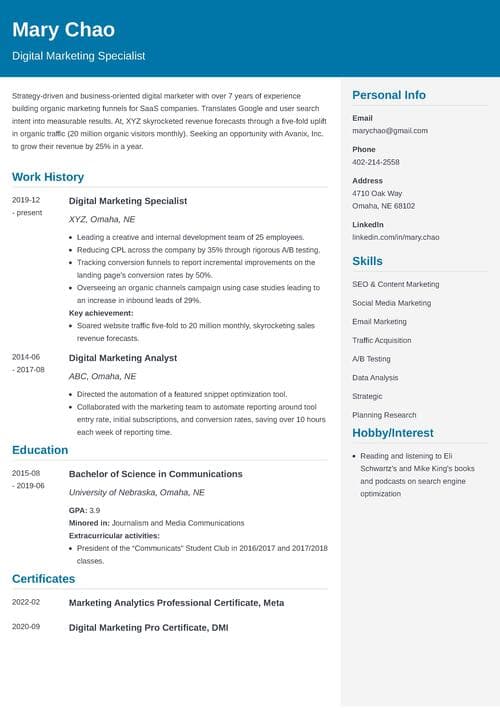
Sample cover letter for a resume— See more cover letter examples here .
Here’s a quick rundown to help you navigate through the article:
- What Is a Cover Letter (And Its Formats)
- How to Format a Cover Letter (Including Layout and Structure)
Key Cover Letter Format Tips
- How to Format an Email Cover Letter
Cover Letter Format Examples for Different Types of Jobs
What is a cover letter.
A cover letter is a document attached to your job application along with your resume . It can be a standard business letter or an email. Each aims to complement the information on your resume and present you as the best candidate for a job.
- Standard cover letter , or an application letter , is the most popular cover letter type. You send it as an attachment in response to a job ad.
- Email cover letter is a shorter cover letter type that you write directly in the email message. It’s less formal.
Choosing either depends on the type of job application process you’re in. Most online applications allow you to upload your resume and cover letter, but in some cases, you’ll be asked to email the recruiter and attach your cover letter there.
First, let’s discuss how to format a standard cover letter:
How to Format a Cover Letter?
See this infographic for the first idea of a correct cover letter structure:
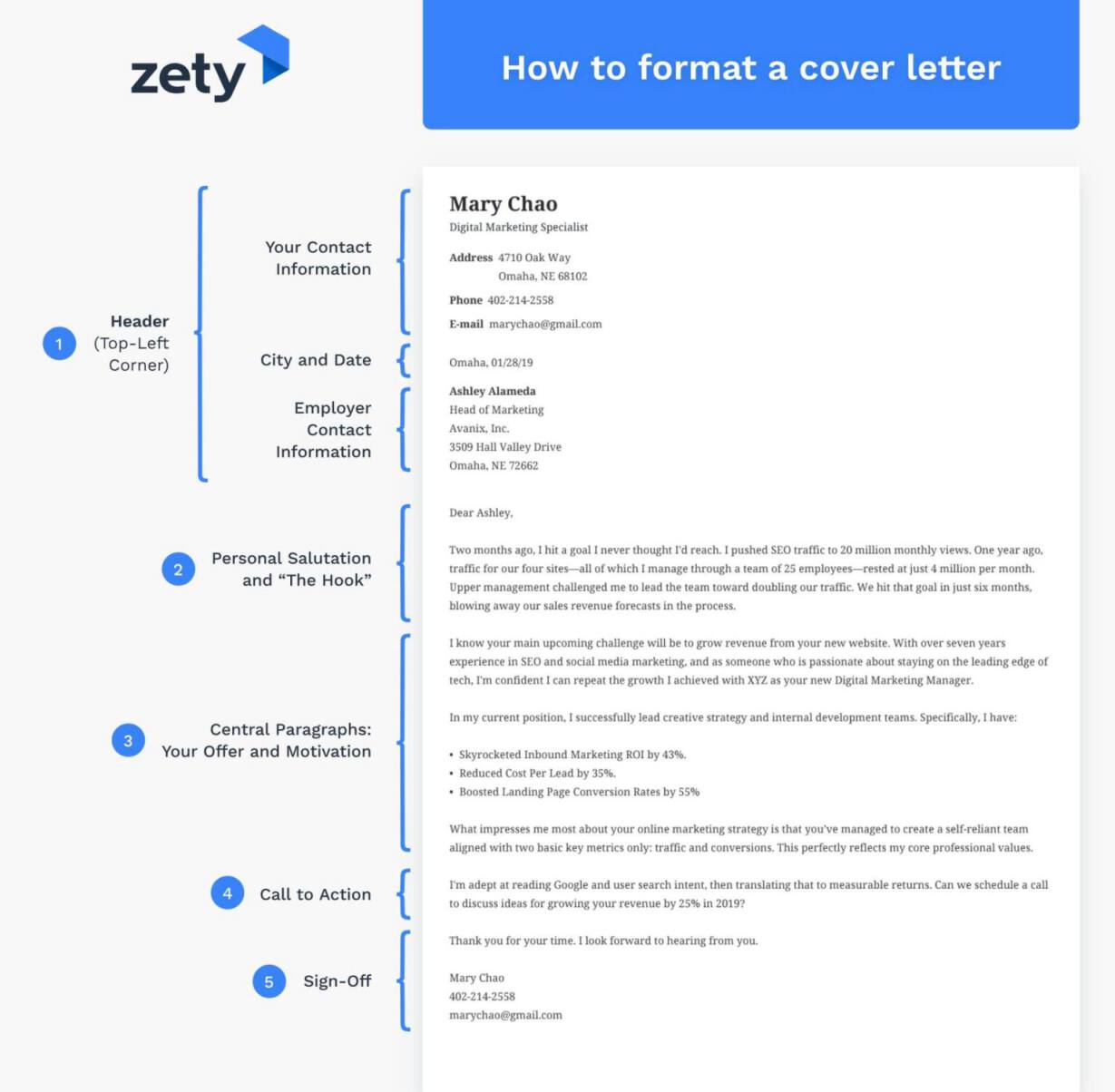
1. Create a Header
A cover letter header is the first thing a hiring manager or recruiter sees, and it carries arguably the most important details of your application—your contact information. The key details are:
- Your contact information : full name, mailing address (optional), phone number, email, and LinkedIn profile handle (optional)
- City and date of writing
- Employer contact information : hiring manager’s or recruiter’s name, job title, company name, and location
See the below example:
Cover Letter Format—Header Example
Digital Marketing Specialist
4710 Oak Way
Omaha, NE 68102
402-214-2558
linkedin.com/in/mary.chao
Omaha, 01/28/2019
Ashley Alameda
Head of Marketing
Avanix, Inc.
2509 Hall Valley Drive
Omaha, NE 72662
2. Start With a Personal Salutation and “The Hook”
Research shows nothing activates your brain like hearing or seeing your name. Open your cover letter with the correct hiring manager’s or recruiter’s name, and you’ll get your deserved attention. Addressing the cover letter right is the most crucial thing in cover letter writing .
You can look for their name in the job description, on the company website, or on LinkedIn. Call the company and ask for the hiring manager’s name if you struggle. By no means should you open your cover letter with “ To Whom It May Concern ” or “ Dear Sir or Madam .” Nothing screams generic more than these two. Go for “ Dear Hiring Manager ” if all strategies have failed.
Cover Letter Format—Salutation Examples
- Dear Ashley,
- Dear Ms. Jones,
- Dear Ashley Jones,
- Dear Hiring Manager,
Now that you have their interest, use one of those opening strategies to create the hook (something that will keep their attention for longer):
- Mention a significant (yet relevant) accomplishment you’re proud of.
- Discuss something you love about the company you’re applying to.
- Comment on the recent award or news the company was honored by.
- Showcase your passion, skill, or other outstanding quality.
- Drop names.
See this example of a powerful opening paragraph with a hook using an accomplishment:
Cover Letter Format—Opening and Hook Example
Two months ago, I hit a goal I never thought I'd reach. I pushed SEO traffic to 20 million monthly views. One year ago, traffic for our four sites—which I manage through a team of 25 employees—rested at just 4 million per month. Upper management challenged me to lead the team toward doubling our traffic. We hit that goal in just six months, blowing away our sales revenue forecasts.
3. Craft Central Paragraphs: Your Offer and Motivation
In the body of your standard cover letter, focus on what you have to offer, not what you want from a job. Emphasize how your expertise will help solve their problems. You can use bullet points to break up the text and highlight your achievements with numbers.
Make them feel special. Your cover letter should say why you’re motivated to join the company and not any other. Once your employer understands they want you, they’ll want to know why you want them.
Cover Letter Format—Central Paragraphs Example
I know your main upcoming challenge will be growing revenue from your new website. With over seven years of experience in SEO and social media marketing, and as someone passionate about staying on the leading edge of tech, I'm confident I can repeat the growth I achieved with XYZ as your new Digital Marketing Manager.
In my current position, I successfully lead creative strategy and internal development teams. Specifically, I have:
- Skyrocketed Inbound Marketing ROI by 43%.
- Reduced Cost Per Lead by 35%.
- Boosted Landing Page Conversion Rates by 55%
What impresses me most about your online marketing strategy is that you’ve managed to build a self-reliant team aligned with two basic key metrics only: traffic and conversions. This perfectly reflects my core professional values.
If you’re beginning your journey, read more: Cover Letter Writing Tips for No-Experience Candidates .
4. Include a Call to Action
The hiring manager wants to give you a shot already, so don’t let them change their mind. Finish your cover letter with a compelling call to action. It should reiterate your value and summarize your qualifications in a single sentence. Then, ask for a call or a meeting. Restate that you can help them achieve their objectives.
Cover Letter Format—Call to Action Example
I'm adept at reading Google and user search intent and then translating that into measurable returns. Can we schedule a call to discuss ideas for growing your revenue by 25% in 2024?
5. End With a Sign-Off
The complimentary closing of a standard cover letter is the same as any other formal business letter. Write “Sincerely,” “Regards,” or “Respectfully,” followed by your full name, one or two lines underneath. Optionally, include a digital copy of your handwritten signature.
Pro tip : When providing a paper copy of your cover letter, handwrite your full name between the signature line and your typed name.
The tips below will let you create and maintain the proper cover letter format and layout:
- Pick a legible cover letter font , like Arial, Calibri, or Verdana, and keep it between 10 and 12 font-size points.
- Set margins to 1 inch on each side of the page.
- Adjust cover letter spacing : double-spacing between paragraphs and 1–1.15 between lines.
- Left-align all contents.
- Limit the length of your cover letter to one page.
- Save your cover letter in PDF. It’s the best choice to keep the cover letter layout intact.
- Name your cover letter file as follows: YourName—JobTitle—CoverLetter.pdf.
When making a resume in our builder, drag & drop bullet points, skills, and auto-fill the boring stuff. Spell check? Check . Start building a professional resume template here for free .

When you’re done, Zety’s resume builder will score your resume and our resume checker will tell you exactly how to make it better.
How to Format an Email Cover Letter?
If you reached this chapter, it means you’re required to send a cover letter as an email message . Below, you’ll learn exactly how to do it.
We won’t cover a section on the layout because email software predetermines it, and you can use what their text editors offer you by default.

1. Write a Strong Subject Line
Statistics show a continual growth in the number of emails sent and received daily. It means that recruiters and hiring managers get their inboxes flooded, too. So, how do you get through? By forging a solid subject line. Focus on the first few words to let the recipient know what you’re about straight away.
In your case, the best approach is to name the position you’re after and include the ID of the role, if it’s available, along with your full name next to it. For example: Software Developer Position (ID:12345) — Johnny Smith.
2. Begin With a Personal Greeting
Compared to a standard cover letter, you’re not required to type your and your employer’s contact information, but you can go directly to greeting them. Yet, again, address them by name.
3. Write a To-The-Point First Sentence
No need for storytelling. Be precise about why you’re sending them the email and what it is about. It can be as follows: Attached you will find my resume with detailed work experience for the position of software developer.
4. Create a Relevant Main Paragraph
To nail this part, read the job description carefully to identify the most pressing needs of your employer (growth objectives, skill set, qualifications) and prove with your professional acumen and accomplishments that you’ll help them meet those needs.
5. Use a Clear Call to Action
Ask them to contact you and restate your offer.
6. End With a Formal Sign-Off
This is where you choose between “Thank You,” “Sincerely,” or “Best regards.” In addition, you need to mention your contact information for them to contact you. Include your full name, cell phone number, and LinkedIn handle (optionally).
7. Attachment(s)
Cover letter enclosures make your email job application complete. Remember to name your files professionally and attach them to your email, for instance:
Now that you’re stocked with cover letter formatting tips see what the best cover letter looks like :
Professional Cover Letter Format
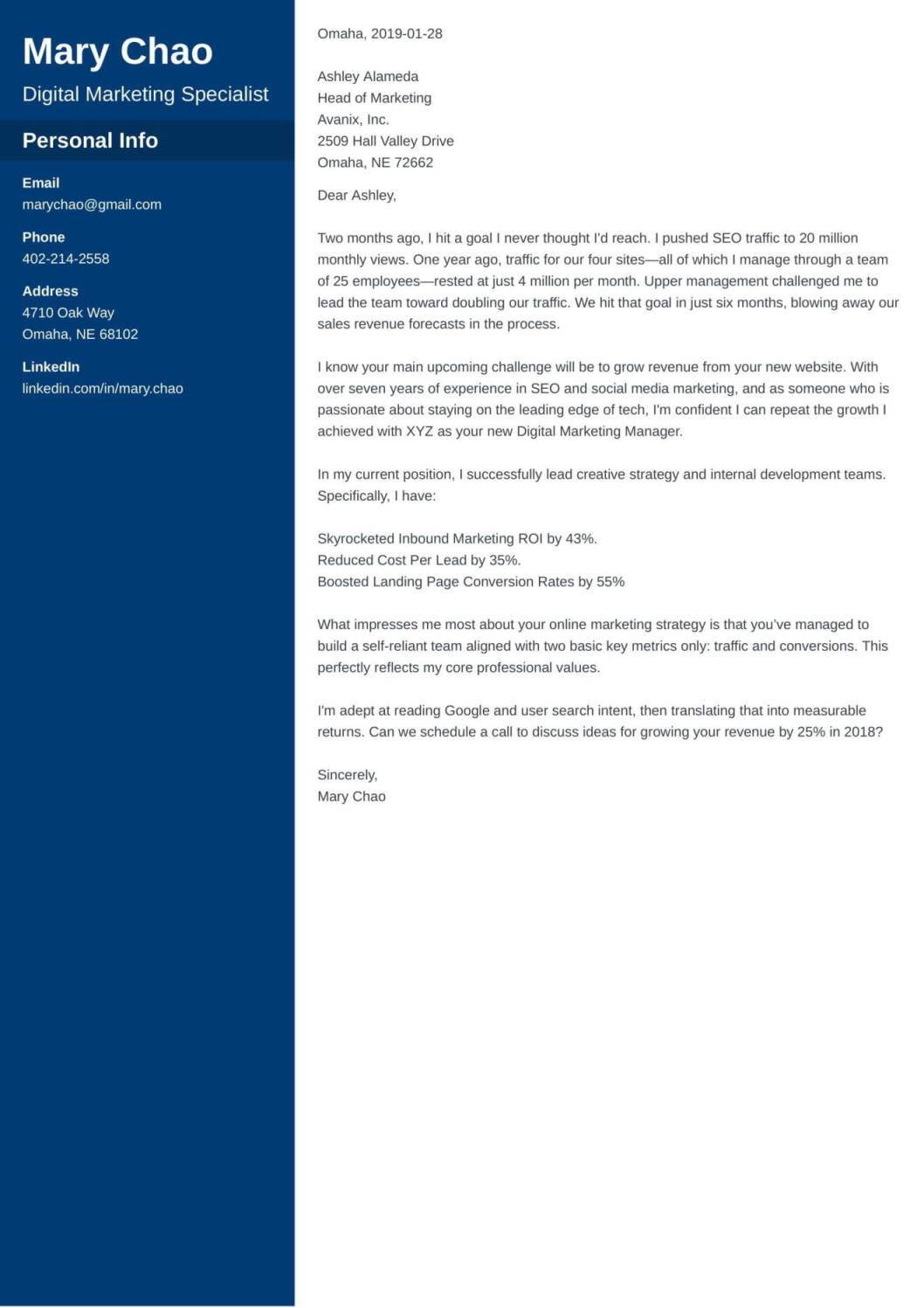
If you want to structure your cover letter to focus on what’s important, you’re right to choose this cover letter format. The darker sidebar covers the usual, leaving your hiring manager with the juicy and plenty of white space which they can rest their eyes on.
That format will also work for these cover letters:
- Accounting Cover Letter
- Administrative Cover Letter
- Business Analyst Cover Letter
- Operations Manager Cover Letter
Business Cover Letter Format

Looking at that cover letter format, you can tell this is a cover letter for C-suite professionals . It’s elegant. It’s neat. It’s perfect. The heading is designed to highlight your position, so use it to your advantage if you’re a senior candidate with an impressive resume.
- Consulting Cover Letter
- Law Firm Cover Letter
- Manager Cover Letter
- Program Manager Cover Letter
Modern Cover Letter Format
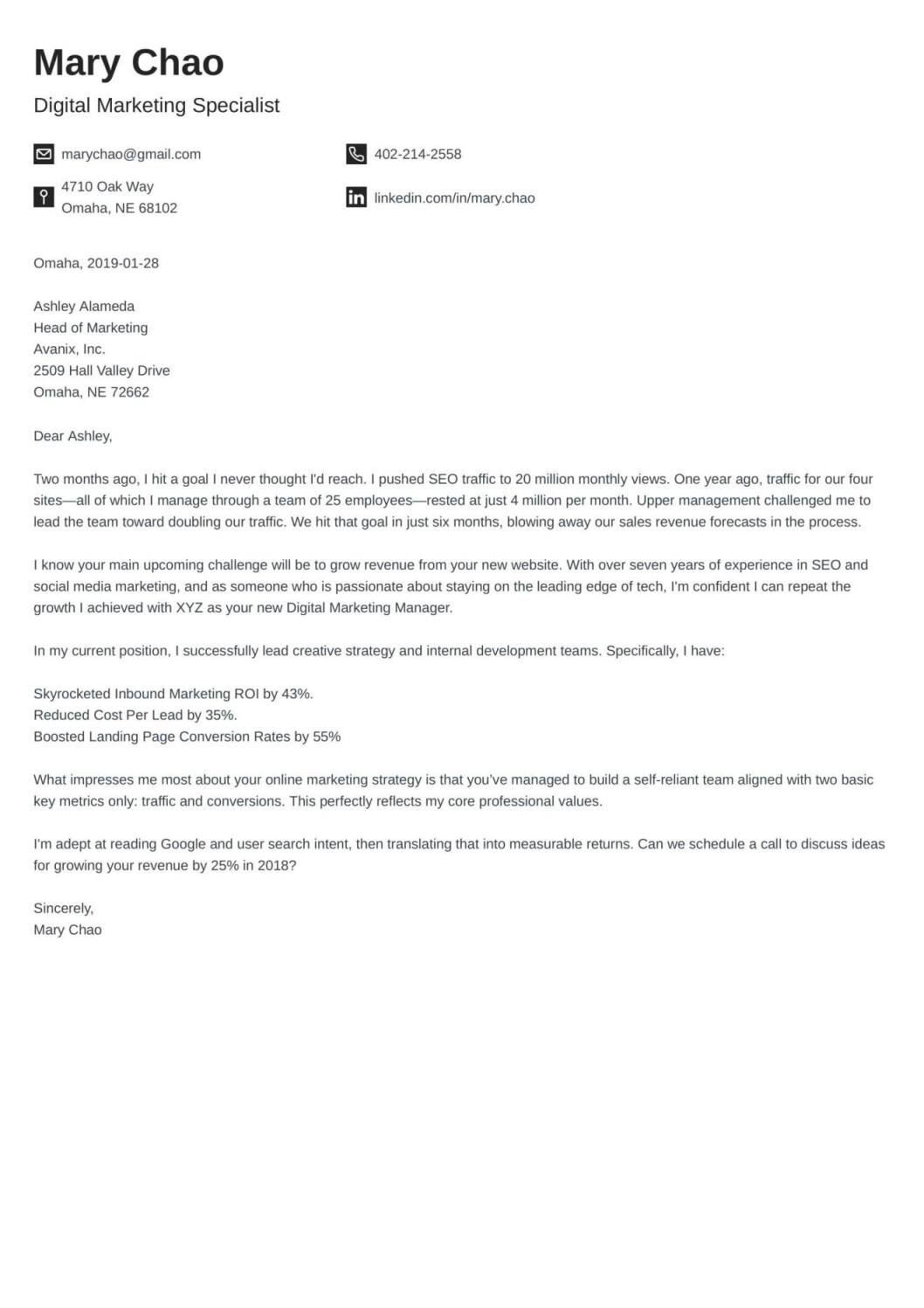
Entry-level candidates—here’s something just for you. A splash of color and square icons will add personal vibes to the cover letter structure. It is precisely what employers are looking for in candidates like yourself.
- Data Entry Cover Letter
- Entry-Level Cover Letter
- Human Resources Cover Letter
- Product Manager Cover Letter
Creative Cover Letter Format

Are you recruiting to the creative industry? Then this is a perfect cover letter format for someone with a knack for design and communication. It’ll help you tell your story thanks to a sleek layout that feels complete.
- Copywriter Cover Letter
- Event Manager Cover Letter
- Journalism Cover Letter
- Public Relations Cover Letter
Basic Cover Letter Format
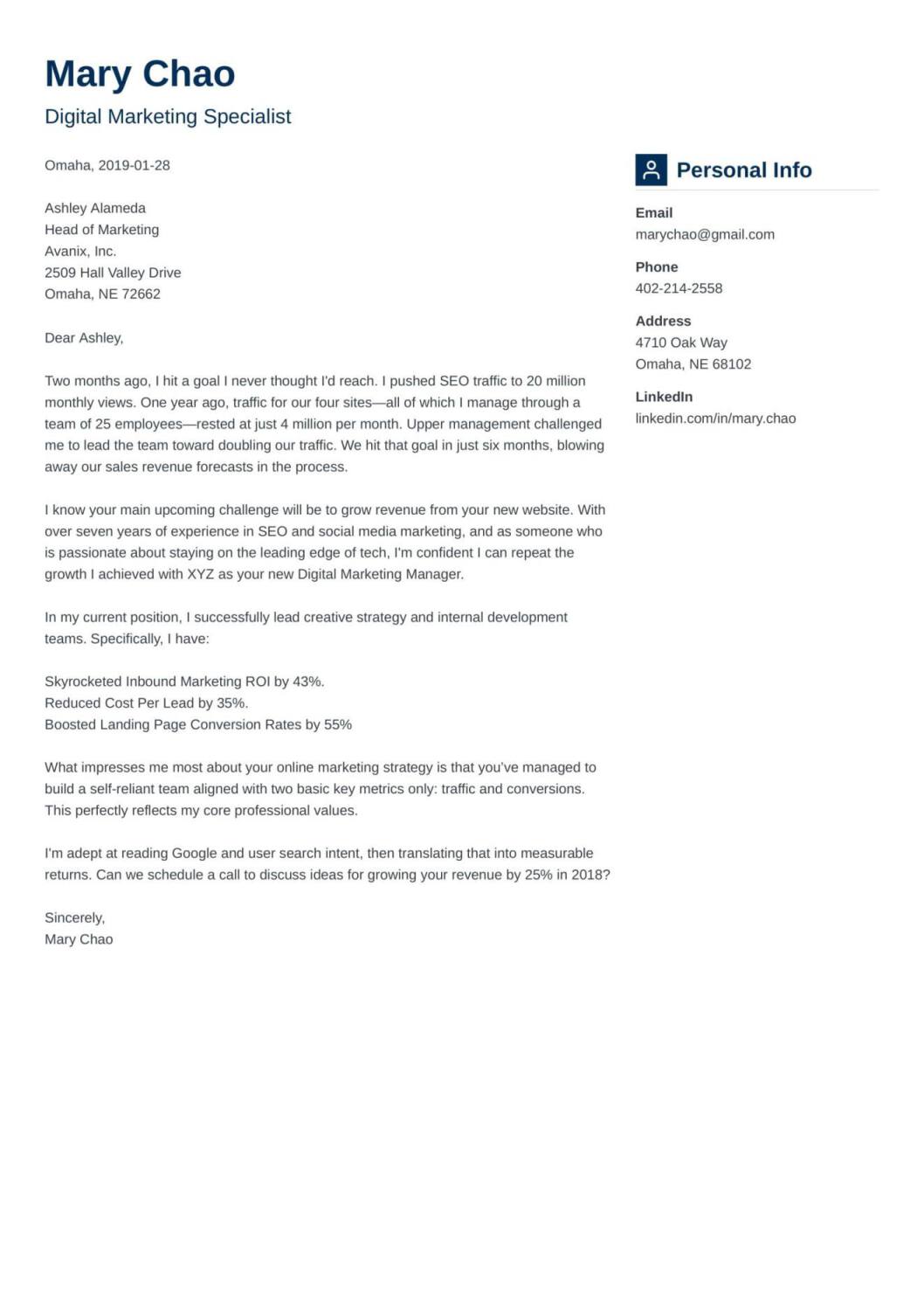
Sometimes you want things to be uncomplicated, be direct, and put your thoughts down uninterrupted. This cover letter format gives you just that. It’s a simple cover letter format that lets your words take the stage.
- Federal Cover Letter
- Personal Assistant Cover Letter
- Social Work Cover Letter
Plus, a great cover letter that matches your resume will give you an advantage over other candidates. You can write it in our cover letter builder here. Here's what it may look like:

See more cover letter templates and start writing.
Key Takeaway
In a nutshell, this is how to format a cover letter:
- Use one-inch margins, single line spacing, and 11 to 12–pt font.
- In the top-left corner, put your contact details, city and date, and the employer's contact details.
- Open with a personal salutation.
- In the body of your letter, open with the hook, make an offer, and explain your motivation.
- Finish with a clear call to action.
- Sign off with a “sincerely” and your full name.
All check? Then, you can be sure you perfected the proper cover letter format for a job application.
Want to learn more about cover letter structure? Have additional questions we didn’t answer above? Drop me a line in the comments, and I’ll be happy to chat!
About Zety’s Editorial Process
This article has been reviewed by our editorial team to make sure it follows Zety's editorial guidelines . We’re committed to sharing our expertise and giving you trustworthy career advice tailored to your needs. High-quality content is what brings over 40 million readers to our site every year. But we don't stop there. Our team conducts original research to understand the job market better, and we pride ourselves on being quoted by top universities and prime media outlets from around the world.
Frequently Asked Questions about Cover Letter Format
How to format a cover letter correctly.
Even if you know what a cover letter should say , it’s still important to structure the message correctly:
- Put your contact information at the top of the letter.
- Address the cover letter to the hiring manager.
- Add today’s date.
- Use a professional cover letter greeting and the hiring manager’s name.
- Open the letter with a hook .
- Explain why you’re a good fit for the position in a few bullet points.
- Finish the letter with a call to action .
- Add a cover letter closing and sign the letter.
How to format a cover letter for an internship?
Candidates applying for an internship can use a business cover letter format . The main difference is that instead of referring to their work experience , they should put emphasis on their academic accomplishments, extracurricular activities , and relevant knowledge they learned while studying—very similar to an entry-level cover letter .
This is how you should format a cover letter for an internship:
- Put your name, field of study, and contact information at the top.
- Address the cover letter to the hiring manager or internship coordinator.
- Add the date.
- Use a professional greeting and the hiring manager’s name.
- Introduce yourself and provide an attention-grabbing accomplishment .
- Explain why you’re interested in the internship and how well you fit the position.
- Provide relevant examples of academic achievements, extracurricular activities, personal projects, etc.
- Finish with a call to action.
Remember to use a cover letter template matching your internship resume . And don’t forget to get into the details of cover letters for internships here.

What’s a good cover letter email format?
A good email cover letter format, or an online cover letter format, is shorter and less formal than a classic cover letter format. You can use such a format when the job advertisement doesn’t specifically request a cover letter. This way, you can introduce yourself and present your qualifications for the job without spending extra time on making the layout for your cover letter or choosing a Word cover letter template .
Follow our guide to read more about the best email cover letter format .

Don't miss out on exclusive stories that will supercharge your career!
Get a weekly dose of inspiration delivered to your inbox
Similar articles

35+ Successful Cover Letter Tips & Advice (With Examples)
Cover letter writing tips—sure to turn any boring letter into something employers want to read.
![cover letter format heading Cover Letter Outline as Suggested by Career Experts [+Tips]](https://cdn-images.zety.com/pages/cover_letter_outline_1.jpg?fit=crop&h=250&dpr=2)
Cover Letter Outline as Suggested by Career Experts [+Tips]
Having trouble putting thoughts to paper? Take the guesswork out—our cover letter outline will make things super simple.

The Perfect Cover Letter for Any Job (Example & Guide)
They say that nothing’s perfect. Challenge that by writing the perfect cover letter to get the perfect job.
Cover Letter Format (w/ Examples & Free Templates)

Give someone who knows nothing about cooking the ingredients to a perfect meal and you’ll end up with a disorganized, very possibly inedible, meal.
The same disorganized, quite possibly tasteless, fate awaits your cover letter if you don’t know how to properly format it.
Getting the cover letter format right is the same as having those coveted cooking skills that can turn the right ingredients into a meal that leaves you wanting more.
Now, if you’re wondering whether your formatting skills are enough to impress recruiters, there’s no need to worry.
This article is going to show you exactly how to format a cover letter the right way.
Here’s what we’re going to cover:
- What Should Go On a Cover Letter?
- How to Format Your Cover Letter
- (Free) Cover Letter Templates You Can Use
- How to Format Your Cover Letter When Sending It Via Email
The Best Cover Letter Format - What Goes on a Cover Letter
Your cover letter’s format is both how your cover letter looks and how it’s structured.
So, cover letter formatting includes everything from page margins, spacing, and font size to how long your cover letter should be, how many paragraphs it should have, and what each paragraph should contain.
Pretty substantial, if you ask us - which is exactly why we’ll go over these elements one by one. Before we do, however, let’s first get the essentials out of the way.
What exactly goes into a cover letter? The short answer is as follows:
- A header , which contains your contact information and the employer’s or recruiter’s contact information.
- A greeting to the recruiter and the opening paragraph , which you want to use to grab the reader’s attention.
- The body of your cover letter , which is between 1-3 paragraphs.
- A closing paragraph , which usually contains a call to action.
- A formal salutation .
And here’s what that looks like in practice:

A Look into Your Cover Letter Format, by Section
In theory, all these rules are pretty straightforward...
But if you’ve ever written a cover letter before, you’ll probably agree with us that actually writing one ain’t all that simple.
In this section, we’ll take you through the entire process of creating a cover letter, section by section!
Starting with:
#1. Header
Your cover letter’s header should contain your contact info, the date, and the hiring manager’s or employer’s contact info.
If you’re wondering which contact information you should include and which you should leave out, here are the essentials:
- Full name and professional title (where applicable)
- Phone number
- Name and professional title of the hiring manager
- Name of the company you’re applying to
- Company address
Here’s a visual representation of this:

If you want to know more about header formatting, such as what you can optionally include and what you should definitely leave out, head over to our guide on how to start a cover letter .
#2. Greeting
After listing your contact information, it’s time to address the cover letter .
First things first: the impersonal and overly popular “To Whom It May Concern” and “Dear Sir/Madam” are yesterday’s news. They’re impersonal and just about every other applicant uses them.
And you want your cover letter to stand out, right?
So, greet the hiring manager directly, instead. For example:
Dear Mr. Brown, Dear Mrs. Waldorf,
If, however, you are unsure about their title, gender, marital status, or pronouns, use their entire name to avoid any mistakes, such as:
Dear Alex Brown, Dear Blair Waldorf,
Alternatively, the recruiter may hold a title, such as Doctor, Professor, or sergeant, or you might be addressing a letter without a contact person.
In such cases, here are some do-s and don’t-s to keep in mind:
Dear John Doe, Dear Mr./Mrs. Doe, Dear Dr. Leonard, Dear Rev. Owen, Dear Marketing Hiring Team, Dear Director of Marketing,
To Whom It May Concern, What’s Up Hiring Team, Dear Sir/Madam, Hey John, Hi there Hiring Team,
#3. Opening Paragraph
The opening paragraph of your cover letter is where the recruiter first gets to really hear your voice. As such, you’ve got to make it count and grab their attention before they move on to the next applicant.
And how exactly do you do that? Well, for starters, avoid being generic. You don’t want your opening paragraph to sound as if you’re applying to dozens of jobs with the same letter.
Instead, you want your opening paragraph to mention:
- Your name, profession, and years of experience.
- 1-2 of your top achievements (to help you stand out).
- The name of the firm and position you’re applying for.
Here’s what this would look like in a cover letter:
My name is Ellen and I’d like to join Company X as a marketing expert. I believe that my 5+ years of experience as a marketing specialist, as well as my skills in PPC management and copywriting, will help me drive new users to your platform Additionally, I believe that my past experience in the financial industry will help me excel at the role.
Struggling with writing your own cover letter introduction? Check out our guide on how to start a cover letter effectively!
#4. Cover Letter Body
The body of your cover letter usually consists of 1-3 paragraphs and is where you convince the recruiter that you're the right person for the job.
We have a few pointers to help you do that:
- Don’t just rehash your CV. The recruiter already read it. Instead, use your cover letter to elaborate on your achievements and back them up with even more evidence.
- Understand the job requirements. Check the requirements for the position in the job listing, see how you can match them with your strengths and qualifications, and use the body of your cover letter to show you’re a good fit for the job.
- Research the company. Also important is to show that you match the company’s culture. Read up about the company you’re applying for and learn what’s their product/service, what are they known for, what kind of culture they have, and so on. Then, in your cover letter, mention a bit about the company’s culture and talk about how you’re a good fit.
And here’s hows the body of your cover letter would look like in practice:
In my previous role as a Marketing Expert, I also handled the company’s Digital Marketing. During the course of one year, I managed the company’s monthly Facebook ad budget, which amounted to $20,000+ and the process of ad creation and management end-to-end. The process involved creating ad copies, images, picking out the targeting, running optimization trials, and so on.
In addition to Facebook advertising, I am also knowledgeable in other Pay Per Click channels, such as:
I actually learned a lot about PPC management basics from your company YouTube channel, and really admire how you guys manage your ad accounts. Since I’m already familiar with how Company X handles ads, I believe that I’d be able to really excel at the role.
#5. Closing Paragraph (And a Call to Action)
Now, how you end a cover letter is just as important as how you start it.
As you wrap up your cover letter, it’s important to do the following:
- Mention anything that you couldn’t in the previous paragraphs . If you have anything left to say, mention it here.
- Thank the hiring manager for their time . Good manners go a long way.
- Finish the cover letter with a call to action . Your cover letter’s last sentence should be a call to action, such as asking the hiring manager to take some sort of action.
Here’s an example of that:
In conclusion, thank you for considering my application. I hope I have the chance to help your company take its marketing initiatives to the next level. It would be great to discuss how my experience so far can make that a reality.
As for your formal salutation, you can use any of the following “tried and tested” greetings:
- Best Regards,
- Kind Regards,
Cover Letter Format Guide
We went over what goes in your cover letter section by section. However, how your cover letter looks on the outside is just as important.
Following some standard formatting tips will show the hiring manager that you took the time and put in the effort to hand in the best version of a cover letter, which is sure to help your case.
Here are the rules that you need to follow:
- Keep your cover letter between half and one page in length to make sure the recruiter actually reads the whole thing (if you had to read 100+ cover letters, you’d want applicants to stick to one page too). That’s between 250-400 words long .
- Use 1 or 1.5 line spacing throughout your text , and double spacing between paragraphs.
- Go for a simple and readable font and set your font size to 11 or 12 pts . Using custom fonts may seem like a good idea, but there’s no guarantee the hiring manager’s computer will have that specific font installed.
- Save your cover letter in PDF format to make sure the layout stays the same despite the type of software or Operating System (OS) that opens it.
Or Choose One of Our Cover Letter Templates
The cover letter is an inseparable part of any application package. As such, you want your cover letter format to be as impeccable as possible.
And while the formatting rules we’ve listed above aren’t complicated to follow, you’d rather not take any risks with your cover letter format.
Want to make sure that your cover letter format is impeccable?
Just use a cover letter template!
The format is done for you - all you have to do is fill in the contents.

Our cover letter templates are well-designed and guaranteed to leave a good impression on the recruiter!
On top of that, all of our templates come with a matching resume template , ensuring that your job application stands out from the rest.
Sending Your Cover Letter Via Email? Here’s How To Do It!
It’s safe to assume that nowadays, most cover letters are sent via email. That means that you’re probably submitting your email in one of two ways:
- Sending it as an email attachment.
- Uploading it to the company’s webpage.
If that’s the case, you’re good with the formatting rules listed above.
If, however, you’re sending your cover letter in the body of the email, here’s what you need to do differently:
- Write a professional subject line. The best and safest formula is “Name - Position you’re applying to” (e.g. “Helen Simms - Application for Marketing Expert Position”).
- Remove the header. As the hiring manager’s contact details and the date are no longer necessary, remove the header altogether and place your contact information underneath the formal salutation.
- Look out for typos. Check your cover letter and then double-check it. Typing on a keyboard can be tricky; sometimes, a typo might just be a matter of fast typing. Avoid that by being extra careful.
And you’re about ready to press “Send.”
Key Takeaways
Your cover letter format is a big part of the impression your job application can make. As such, it’s important to get the formatting right.
Here are the main points this article covers to achieve that:
- Make sure to structure your cover letter the right way.
- Address your cover letter the right way and write an attention-grabbing opening paragraph.
- Wrap up your cover letter with a call to action.
- Pay attention to the margins, space lining, font size, and cover letter length.
- If you’re sending your cover letter as the body of your email, make sure to tweak the formatting accordingly.

To provide a safer experience, the best content and great communication, we use cookies. Learn how we use them for non-authenticated users.
6 Tips for Formatting a Cover Letter

Your cover letter needs to grab the recipient’s attention and make an impact. It’s about showcasing your skills and standing out from other applicants.
Details matter, so it’s important to get the formatting right. A cover letter format is similar to a one-page business letter format. It should have one-inch margins on all sides, size 10–12 font in Times New Roman or Calibri, and 1.15 line spacing.
Once the formatting is squared away, your job is to make sure your cover letter is concise, relevant, and easy to read. Whether you’re a seasoned professional or just starting out, this comprehensive guide will help you stand out in today’s competitive job market.
Give your writing extra polish Grammarly helps you communicate confidently Write with Grammarly
What is a cover letter format?
A cover letter format serves as a structure that organizes the information within a cover letter. Cover letters, like standard one-page business letters, include:
- A salutation
- An opening paragraph
Body paragraphs
- A closing paragraph
Cover letter outline
Follow this outline to write a cover letter that is concise and professional.
Cover letter headers should include the following details:
- The date you wrote the letter
- Your contact information: name, phone number, and email address
- The recipient’s contact information: name, company, and company address
Salutation and introduction
In your salutation, formally address the hiring manager by name.
Dear Ms. Lahiri,
When you don’t know the hiring manager’s name, try to narrow it down by team.
Dear Communications Team,
As a last resort you can use the generic “hiring manager” title.
Then, in a sentence or two, open your cover letter by explaining why the position appeals to you. In three sentences or less, highlight your most relevant experience based on the job description to show why you’re a good fit and compel hiring managers to keep reading. You’ll go into more detail in the next section.
The body of your cover letter should be two to four short paragraphs. This is where you describe relevant, quantifiable accomplishments and skills that fit the job description. Be specific about what makes you a good fit for that specific position and company.
In a few sentences, wrap up your cover letter with a conclusion and a call to action. The conclusion may expand on your interest in the company and why you want to work there. Then, thank the hiring manager for their time and consideration.
The following are examples of effective cover calls to action:
- I would appreciate the opportunity to discuss my qualifications further. I look forward to learning more about the position and your team.
- I welcome the chance to contribute my skills and work ethic to [company name]. I look forward to discussing how my background aligns with your needs. Thank you for considering my application.
- I am excited to learn more about the position and [company name], and I look forward to hearing from you.
At the end of your cover letter , sign off professionally and sign your name. Any of the following work as sign-offs:
- Respectfully
6 tips for formatting a professional cover letter
Now that you’ve written your cover letter , clean it up with these formatting tips.
1 Font style and size
Use a clean font style, such as Arial, Calibri, or Times New Roman. The cover letter font size should be 10 to 12 point for the body text. Use a slightly larger font size, like 14 or 16 point, for the header.
One inch on all sides is standard for cover letter margins. This provides a clear and consistent border around the content. If you do need to alter this standard, do not use a margin narrower than 0.75 inch or wider than 1.25 inches.
Use single-spacing or 1.15 line spacing for the body of the cover letter. Align the text to the left-hand side and maintain a consistent margin. Insert a blank line between paragraphs to create visual separation and make the content easier to read.
4 File format
The recommended file format for a cover letter is PDF (portable document format). Saving your cover letter as a PDF ensures that the formatting and layout remain consistent across different devices and operating systems. It also prevents the content from being easily edited or altered by the recipient.
5 File name
Your cover letter file should begin with your first and last name, include the words “cover letter,” and specify the job title or company name. Separate words within the file name using underscores (_) or hyphens (-) instead of spaces to prevent any issues with file compatibility.
A cover letter should be a concise and focused one-page document. Around 250 to 400 words should cover the necessary information—and keep the reader’s attention without overwhelming them with excessive details.
Cover letter format example
Jeremy Bleau
617-555-4938
June 27, 2024
Nitesh Sharma MediGlobal 123 Main Street Redwood City, CA 94063
Dear Nitesh,
I’m writing to express my interest in the position of Senior Product Manager at MediGlobal. I have a deep understanding of digital product ecosystems and a passion for data-driven solutions in the healthcare industry. I’m excited to discuss how I can contribute to the ongoing growth and success of your organization.
I have more than five years of experience in marketing and digital product management, including three-plus years specifically in the medical device and biotech sector. Additionally, I have a proven track record of driving strategic global marketing initiatives, with a success rate of 85% in increasing B2B brand awareness via email marketing and search, resulting in a 21% boost in annual revenue. My expertise lies in developing and implementing shared analytics strategies that align with company objectives and enhance overall reach.
Beyond my strategic marketing skills, I bring a deep passion for data and analytics, recognizing their crucial role in informing decision-making and driving business outcomes. I’m adept at leveraging data, capturing analytics, and ensuring interoperability between digital assets and services. Throughout my career, I have established strong relationships with key opinion leaders and collaborated closely with R&D, IT, and cross-functional partners to drive digital asset development. My entrepreneurial mindset, coupled with my strategic thinking and execution abilities, enables me to identify unmet needs and implement optimal solutions.
I am excited about the opportunity to contribute to the growth of MediGlobal and its digital care team applications and welcome the opportunity to discuss in more detail how my skills and expertise align with the goals and requirements of the Senior Product Manager role. Thank you for considering my application. I look forward to the possibility of contributing to the success of MediGlobal.
Cover letter format FAQs
What is the purpose of formatting a cover letter.
Formatting a cover letter is important because it helps you present yourself professionally and makes your letter easier to read for the person reviewing it.
What are the key components of a cover letter?
The key components of a cover letter are:
- An introduction
- A conclusion
What are 6 tips for formatting a cover letter?
- Use a simple font like Times New Roman or Arial in 10 to 12 point.
- Set margins to one inch on all sides.
- Use 1.15 line spacing throughout and insert a blank line between each paragraph.
- Format your cover letter as a PDF.
- Name your cover letter file with your first name, last name, the words “cover letter,” and the job title or company name.
- Keep your letter within 250 to 400 words and less than one page.

How to Format a Cover Letter for 2024 [ + Examples]
Looking for a job but can’t remember the last time you wrote a cover letter? Keep reading to learn how to format a cover letter that lands your dream job.
Build my letter

As seen in:
What is a cover letter?
A cover letter is a document you use to apply for a job with your resume. The cover letter lets you introduce yourself to the employer and share your experience and enthusiasm for the role.
Most job ads require you to submit a cover letter while some make it optional. In both cases, you should write a cover letter to include with your job application and provide more information to sway recruiters in your favor.
In his article, we’ll discuss:
TABLE OF CONTENTS
- The correct cover letter structure
How to format a cover letter for email
Cover letter format examples, how to format a cover letter with the proper structure.
Want to jump ahead and create your cover letter in just a few minutes? Use our quick and easy Cover Letter Builder , or check out our library of 15+ cover letter templates for extra inspiration.
Format your header correctly.
The first thing that should appear in every cover letter header is the applicant’s contact information. Doing this allows recruiters to immediately identify you with your accomplishments so make sure your name is at the top.
The contact information includes:
- Phone number
- Basic location (city, state and ZIP code)
- LinkedIn or relevant social media accounts (optional)
Make the recruiter’s job easier by using a professional-sounding email that preferably includes your first and last name.
Below your contact information, you will add:
- The date you plan to send the letter
And then the hiring manager’s information:
- Hiring manager’s name and job title
- Company name
- City, state and ZIP code
Here’s how it should look:
- Sept. 23, 2023
- Lisa M. Wong
- The Atlanta Gazette
- 341 12th Ave.
- Atlanta, GA 30304
Greet the hiring manager.
We always recommend you strive to find the name of your recruiter or hiring manager because it shows you’ve put the effort in to personalize your cover letter.
For example:
Dear Jamie Ferrer,
Try to use the recipient’s full name, and avoid outdated terms like “Mr.”, “Ms.” or “Mrs.” These identifiers imply a person’s gender or marital status, neither of which you’re aware of nor are relevant in a professional setting.
If you’ve exhausted all channels and can’t find the recruiter’s name, you should use “Dear Hiring Manager” only as a last resort. Check out our article on addressing a hiring manager when you don’t know their name for even more tips.
Examples of cover letter greetings when you don’t know the recipient’s name
- Salutations by job title
- Dear Hiring Manager,
- Dear HR Director,
- Dear Marketing Manager,
- Salutations by team or department
- Dear Customer Service Team,
- Dear Research and Development Department,
Never, under any circumstance, use “To Whom It May Concern”. This salutation denotes a total lack of effort and many recruiters are put off by it.
Write a compelling opening paragraph.
Begin your cover letter with a strong first paragraph that expresses your desire for the job and gives a peek at your credentials for the position.
Formula for an opening paragraph
I saw the opening for [job title] and knew my [1-3 skills] and [X] years of experience in [area of expertise] made me the ideal candidate for the [Company name] team.
Opening paragraph example
“When I saw the job advertisement for the junior account executive position at LCL Global, I knew I had to take advantage of the opportunity after excelling as a copywriter with brands like Burger King, Lancome and Porsche for the past three years.”
Share top achievements in the body paragraph.
When writing your cover letter’s body, you need to take the time to craft a brief story of your career.
You can include several paragraphs in the cover letter body provided you’re sharing relevant information. You can also use bullet points to break down the information for easier reading.
Share the milestones that made you successful in previous roles. Explain how you got to where you are and how this experience can help you bring similar results to the new position.
A few examples of achievements you can include in your body paragraphs are:
- Projects you’ve led
- Money saved by your productivity/efficiency
- Positive feedback from clients
- Research you conducted that benefited the company
- Training you imparted to staff
- Deals and negotiations that were a win
Body paragraph example
“As a store manager in one of the busiest stores in the largest shopping mall in the state, I’ve trained over 400 employees in sales, stocking, customer service and warehouse operations. I’m confident I am ready for a promotion to district manager, partly because my peers have consistently recognized me for outstanding leadership and for increasing and maintaining a high level of sales and client satisfaction. When I began my career as a cashier, I knew my discipline, attention to detail and interpersonal skills would allow me to be a district manager one day.”
Seal the deal in the closing paragraph.
Your closing paragraph should tell the hiring manager you’re excited about the prospect of working for their company. You should be straightforward and confident about your desire for a job interview. Close with a summary of your top qualifications and finish with a compelling call to action.
Cover letter closing paragraph example:
“My content and UX writing skills and SEO experience make me an ideal candidate for this position. I look forward to hearing from you to discuss how I can be an asset to the team.”
And finally, remember to add a proper sign-off and your name.
List of appropriate cover letter sign-offs:
- Best regards,
- Kind regards,
- Respectfully,
- Thank you for your consideration,
If you need more help with writing and even more examples, check out our extended cover letter writing guide .
Write my cover letter now
Employers may require you to submit a cover letter via email. You can opt for writing your cover letter in the body of the email or send it as an attachment, but never do both.
Here are the steps for sending your cover letter as an attachment via email:
Write a subject line that quickly identifies you.
Your email’s subject line should include:
- The desired job title
- Job ID (if available)
You can find the job ID in the job advertisement, but your name and job title will suffice if there isn’t one.
Senior Software Engineer – Paul Lipovetsky (ID: 38461)
Draft a brief body paragraph.
Don’t just attach your letter and send it without context. Share a short introduction where you share your name, your motivation to apply to the job and one or two professional qualifications.
Here’s an example of a cover letter email:
Dear Bruno,
Please find a copy of my cover letter attached to this email with an overview of my qualifications for the position of Senior Software Engineer at XYZ Company ID: 38461.
After seven years in the startup industry in Silicon Valley, I am eager to challenge myself in a new position and offer my expertise in object-oriented design (OOD) and mobile applications.
I’m looking forward to speaking with you.
Best regards, Paul Lipovetsky
Don’t forget to attach your letter!
Finally, attach your letter to the email. You should attach your letter as a PDF to prevent editing or tampering. However, always follow the instructions of the recruiter or job advertisement.
You should also be naming your cover letter file with your name, for example, “Paul Lipovetsky CoverLetter.”
Writing a cover letter directly via email
When writing your cover letter directly in the email, you should follow the same rules for writing a cover letter. The main difference is that you won’t include a copy of your cover letter as an attachment.
When drafting a cover letter directly via email, include the following:
- A subject line
- Introduction paragraph
- Body paragraph(s)
- Closing paragraph
Here’s an example of a cover letter format for email:
These cover letter examples will show you our top-rated cover letter templates and the right content for various in-demand jobs. Feel free to pick your preferred cover letter format and edit it with your information.
Accountant cover letter
This accountant cover letter does a great job of sharing highly relevant expertise for the job in the body paragraph. Pairing the letter with this traditional style template makes it all the more appropriate for an accounting job.
Project manager cover letter
Starting strong by sharing their experience in top companies, this cover letter cleverly hooks the reader in the opening paragraph. A simple and clean template like this one is ideal for practical job seekers like this project manager.
Registered nurse cover letter
This registered nurse cover letter shows how to use bullet points in the body paragraph, making this a straightforward and easy-to-read letter, enhanced by our Charismatic template.
Customer service representative cover letter
The compelling closing statement sets this customer service representative cover letter apart, demonstrating the candidate’s communication skills. The Whitespace template leaves plenty of room for this slightly longer letter.
High school teacher cover letter
This brilliant cover letter contains professional skills, qualifications and highly relevant knowledge for this education role. This job seeker opted for one of our bolder templates that will surely leave a good impression.
Sales agent cover letter
This sales agent cover letter hits the mark by listing all the requirements this role entails, assuring recruiters they are well-trained for the job. The pop of color makes this otherwise simple template a favorite for many job seekers.
View all cover letter examples
Key takeaways
As an overview, make sure you do the following formatting for your cover letter:
- Always accompany your cover letter with an equally strong resume .
- Ensure your cover letter includes the five essential sections: header, greeting, opening paragraph, body paragraph and closing paragraph .
- Include your contact information, date, recipient name and address in your header.
- Greet your recipient by name, for example, “Dear Suzanne J. Phillips” or “Dear Hiring Manager.”
- Introduce yourself and share one or two relevant achievements to hook the reader in the opening paragraph.
- Share your accomplishments, skills and qualifications in the body paragraph. You can do this in paragraph form or bullet points.
- Write a compelling closing statement with a call to action for a future interview. Don’t forget to sign off with your name or signature.
- Opt for a professional cover letter template or use a Cover Letter Builder that saves you time and perfects your cover letter’s formatting.
Build my cover letter
Learn more about cover letters
How to Write a Cover Letter + Examples
CV vs Resume
3 File Formats to Use for a Resume
Is a cover letter ever optional?
Smart job seekers include a customized cover letter for every job application. Even when not mandatory, writing one allows you to show off your communication skills and willingness to go the extra mile. Additionally, writing a cover letter will enable you to draw direct connections between your skills and experience and the requirements of the role. A cover letter is optional only if the job ad explicitly states not to include one with your application.
Do I need a cover letter for every job application?
Yes. Applying with a generic cover letter is a sure way to get passed over for a job. Customizing your cover letter with skills and tailored accomplishments that demonstrate you possess the correct skill set to excel at one particular position is crucial. Remember that employers are looking for specific qualifications and expect to see them in your cover letter and resume.
How to write a cover letter with no experience?
If you’ve never had formal work experience, your cover letter should focus on experiences in other settings that show you have the necessary knowledge for the job. You can mention academic achievements, internships, hobbies or volunteer work related to the qualifications you need for your desired position.
You should focus on soft skills that help you be an efficient worker and collaborator, which is key for any role. You can also find transferable skills from seemingly unrelated experiences and apply them to this new job. We have a whole article you should check out dedicated to including transferable skills on a cover letter .
What are some common mistakes when writing a cover letter?
Some things you should never do when writing a cover letter are:
- Extending your cover letter beyond one page.
- Not utilizing the correct cover letter format.
- Rewriting what’s already on your resume.
- Using informal greetings or sign-offs.
- Never proofreading.
If you’re worried about making a mistake when writing a cover letter, check out our “ 8 Cover Letter Mistakes ” article.
See more on our FAQ page
More resources
3 Qualities of a Great Cover Letter
How to Showcase Your Soft Skills in a Cover Letter
Cold Contact Cover Letter Example & Expert Writing Advice
About the Author
Gabriela Hernandez • CPRW, Career Advice Expert
Gabriela Hernandez is one of LiveCareer's resident writers. She graduated from the University of Puerto Rico with a degree in Journalism. Throughout her career, she has tackled copywriting, blog articles, journalistic writing, academic writing, resume writing, and even prose and verse.
Please rate this article
As seen in *
*The names and logos of the companies referred to in this page are all trademarks of their respective holders. Unless specifically stated otherwise, such references are not intended to imply any affiliation or association with LiveCareer.
- English (UK)
- Cover Letter
How to Format a Cover Letter: Examples & Tips for 2024
A proper cover letter format can score you a few points. Read on, and learn how to format your cover letter so it won't go unnoticed.
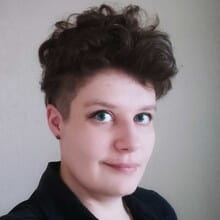
Imagine you’re a recruiter, and you’ve got a pile of 300 cover letters to sift through. Which ones would you choose? The ones with tiny font, typos, or with sloppy structure, or the ones that invite you to read and are easy to scan? Take a few minutes and learn how to format your cover letter, so you won't get ignored.
This guide will show you :
- Cover letter format examples that will land you the interview.
- How to format a cover letter, so it won't go unnoticed.
- Avoid rookie cover letter formatting mistakes.
- What is the best cover letter structure for different types of jobs.
Save hours of work and get a cover letter like this. Pick a template, fill it in. Quick and easy. Choose from 20+ cover letter templates and download your cover letter now.
Create your cover letter now

What users say about ResumeLab:
I had an interview yesterday and the first thing they said on the phone was: “Wow! I love your cover letter.” Patrick I love the variety of templates. Good job guys, keep up the good work! Dylan My previous cover letter was really weak and I used to spend hours adjusting it in Word. Now, I can introduce any changes within minutes. Absolutely wonderful! George
Cover Letter Format Example
Sonia F. Quattlebaum
Senior Android Developer
1641 McDonald Avenue
Apopka, FL 32703
407-889-0490 [email protected]
linkedin.com/in/sonia.quattlebaum/
github.com/soniaquattlebaum
Mark M. Elliot
IT Hiring Manager
Skyscraper Avenue
Tampa, FL, 33606
Dear Mr. Elliot,
Cindy Murphy suggested that I apply—she knows how I discovered a vulnerability in the municipal parking app in Rocherster MN that could have given hackers access to all information on the citizens’ phones, and stepped up to fix it.
I see you’re looking for an Android developer with experience in leading cross-departmental efforts to create highly secure financial apps. At Goldcoin Bank, I:
- Oversaw the development of a mobile banking app that was ranked #1 in the Most Secure Bank Apps ranking.
- Collaborated with UX/UI designers and UX writers to provide the best customer experience, as proven by the 4.5-star rating of Bigcoin’s app.
- Ensured that the app was ready for release 2 months before schedule.
When Bigbank introduced a new-generation fraud alert system in its mobile banking app, I could not help but admire the hard work and dedication of its developers—and I was not surprised when it won the Banking App of the Year award. It would be an honor to join your team and make Bigbank Mobile even more reliable and secure in the face of ever-changing cyberthreats.
Can we schedule a meeting next week to discuss how I could contribute to the upcoming versions of Bigbank Mobile?
Sonia Quattlebaum
PS. I can’t wait to tell you how I helped a well-known online store prevent a massive cyber attack that put the bank accounts of 50,000 clients who used its mobile app in immediate danger.
This cover letter follows all the best practices for cover letter structure and format. Let’s go through all the steps you need to have a cover letter like that.
1. How to Format a Cover Letter Like a Pro
The best practices of formatting a cover letter are always the same, no matter if you’re writing your first cover letter with no experience or applying for an executive job. To make sure your cover letter format is as effective as possible, follow these steps:
- Adjust the page layout and the font settings so that your cover letter looks professional
- Start your cover letter with a header
- Use the proper greeting
- Open with an attention-grabbing paragraph
- In a separate paragraph, list specific achievements that prove you’re the best person for this job
- Add another paragraph where you “confess” your passion for the company
- End your cover letter with a call to action
- Sign off according to business etiquette rules
- Add a P. S. if necessary
This cover letter format works wonders for entry-level candidates and seasoned pros alike, so it’s worth mastering no matter where you are in your career. Now we’ll look at each step in more detail.
2. Set Up Your Cover Letter Format: Page Layout and Fonts
If you use a cover letter template , this part of cover letter formatting will take care of itself. But if you prefer to start with a blank page, here’s how to format a cover letter:
- Set the page margins to 1” on all sides
- Pick a classic typeface that matches your professional resume font , such as Arial, Helvetica, Calibri, Times New Roman, or Verdana
- You can also try fonts like Lato, which looks professional but friendly, or Garamond, a classic font that looks good when applying for academic jobs
- When in doubt, stick with the default font in your word processor
- Avoid fonts that look handwritten or otherwise unusual, even if you’re applying for a creative job
- Set the line spacing to 1 or 1.15
- Set the font size to 11 or 12 pt
- Make sure you add a blank line between paragraphs
- Align the paragraphs to the left—justifying looks good in newspapers, not in business letters
Expert Hint: Save your cover letter as a PDF file so that it looks the same on all devices. A Word file that looks great on your computer can look like a trainwreck when opened on someone else’s device.
3. Format Your Cover Letter Header
Every business letter needs a header, and cover letters aren’t an exception. The header goes into the top left corner of the page and contains contact information—both yours and the recruiters. Addressing a cover letter is pretty straightforward in most cases. Here’s a cover letter header template that you can copy and paste straight away:
Cover Letter Heading Format — Basic Template
Your Job Title
Street, City, State
Phone Number
LinkedIn Profile
Hiring Manager’s Name
Hiring Manager’s Job Title
Company Name
If it makes sense to include other professional online profiles like GitHub, feel free to do so. Just avoid mentioning any personal profiles , especially if they contain potentially awkward photos or posts. Oh, and remember to use your “best” email address for your job application. It’s hard to take a candidate seriously if their email address is [email protected].
This cover letter header is an indispensable part of a business cover letter format if you send your cover letter as a PDF or print it out. If you choose to send your cover letter in the body of an email , omit the header and go straight to the opening.
Expert Hint: Do your best to find out the hiring manager’s name. Sometimes it’s mentioned in the job ad. But if it’s not, do some research on LinkedIn, browse the company’s website, or do a quick Google search.
4. Craft a Successful Cover Letter Opening
The cover letter header was easy. Now comes the hard part… but we’ll make it easy, too. First, you need to greet the reader. If you know the hiring manager’s name, choose between these three salutations:
Cover Letter Format—Salutation
Dear Mr. Jones / Dear Ms. Jones,
Dear Alex Jones,
Pick the first variant ( Dear Mr. / Ms. Lastname ) if you’re formatting a cover letter for a federal job or any other position with a formal work environment. Most business cover letters for corporate positions fall under this category, too. If you can’t tell the hiring manager’s gender by their first name, opt for Dear First-name Last-name to avoid awkward misunderstandings.
Last but not least: you can also address the hiring manager by their first name only, but only if you know that your prospective employer has a relaxed company culture.
But… what if you couldn’t find the hiring manager name, even though you tried? In this case, it’s acceptable to write Dear Hiring Manager . It’s not as personal as greeting someone by their name, but it’s still better than these opening formulas:
To Whom It May Concern,
Dear Sir or Madam,
Good morning,
The first two greetings are way too impersonal and outdated. Hi there is too informal, and starting a letter with Good morning is not the best idea—you never know if your letter will actually be read in the morning.
5. Write a Compelling First Paragraph
This part is important when it comes to the cover letter formatting. You’ve attracted the reader’s attention by mentioning their name. Now you want them to continue reading. So… how do you start a cover letter without turning the reader off immediately? Your best bet is to mention a big professional achievement and suggest that you could do the same for your new employer.
Cover Letter Format Example—Opening
Well, that’s nice if you do have a big achievement to brag about. But what if you’re just starting out in your career? You can opt for these attention-grabbing strategies:
- Drop a name
- Congratulate the company on an award or some other achievement
- Mention a fact you love about the company
But whatever strategy you pick, be specific and straightforward. Don’t write things like this:
This intro contains zero proof that the candidate is either an excellent customer service professional or at least passionate about this specific company.
6. Let Your Cover Letter Format Prove That You’re the Best Candidate
Done with the intro? Make a new paragraph (remember to leave a blank line between paragraphs!) and show why you’re the best person to solve the company’s specific challenges.
How do you approach this paragraph? First, re-read the job ad and research the company’s website. Are they hiring people for a new project? Are they looking for a pro who can help the company navigate a specific challenge? Once you’ve found the answer, make it clear that you understand the company’s unique needs .
After that, list a few relevant achievements that clearly show you’re the superhero the company needs. By “relevant” we mean “closely related to the skills and requirements listed in the job ad”. You can list these achievements in plain text, but bullet points are easier to read. Here’s an example:
Cover Letter Formatting Example —Paragraph
I see you’re looking for an Android developer with experience in leading cross-departmental efforts to create highly secure financial apps. At Bigcoin Bank, I:
- Oversaw the development of a mobile banking app that was ranked #1 in the Most Secure Bank Apps ranking
- Collaborated with UX/UI designers and UX writers to provide the best customer experience, as proven by the 4.5-star rating of Bigcoin’s app
- Ensured that the app was ready for release 2 months before schedule
Note how the candidate uses numbers to describe their achievements. This makes their expertise more believable. Let’s look at another example and compare the two:
This example is full of meaningless achievements and unproven claims. Also, why was the software dev responsible for the aquarium? But anyway, no one cares.
Double your impact with a matching resume and cover letter combo. Use our cover letter generator and make your application documents pop out.
CREATE YOUR COVER LETTER NOW

Want to try a different look? There's 21 more. A single click will give your document a total makeover. Pick a cover letter template here .
Nail it all with a splash of color, choose a clean font, and highlight your skills in just a few clicks. You're the perfect candidate, and we'll prove it. Use our resume builder now .
7. Make it Clear that it’s Your Dream Job
Time for another paragraph in your letter of application ! Now that you’ve explained why you’re the best person for this job, it’s time to show why this job is the best opportunity for you.
Why is it so important to write about it? Well, if you don’t really want to work for this specific company, why should hiring managers bother to invite you? So go ahead.
Compliment the company on a recent achievement, praise its values (and explain how they resonate with your values), show your excitement about its upcoming projects. Don’t be afraid to confess your passion.
Cover Letter Formatting Example—Paragraph
Make it very clear that you’ve tailored this paragraph to a specific company. If you write a bunch of generic clichés , the hiring manager will assume you’ve copied and pasted this paragraph from somewhere else.
This candidate might think they’re a great fit, but no recruiter would agree with them.
8. Add a Confident Call to Action
Your cover letter isn’t a school essay. You write it with a specific goal in mind: namely, you want the recruiter to take action and call you back. So make a new paragraph and ask the reader to take action—this is an important and often overlooked element of cover letter structure. This is what a cover letter call to action can look like:
How to Format a Cover Letter—Call to Action
This call to action is confident and professional. See how this candidate makes a specific offer? They haven’t been hired yet, but they’ve already got some ideas on improving the company’s business results.
Look, no one cares. If you can’t explain how you’re going to contribute to the company’s success, you’re not getting hired. Period.
9. Follow Best Practices in Cover Letter Formatting When Signing Off
It’s time to end your cover letter . Write “Sincerely” (or some other classic business letter closing) and type your name. It’s also a good idea to repeat your contact information under your signature. If the recruiter wants to contact you straight away, they won’t have to waste their time looking for your phone number or email address.
You can also add a P. S. at the very end of your cover letter. For example, you can promise to tell a story about a hard-to-believe achievement. The hiring manager might call you back just to hear the story!
Expert Hint: Before you submit your cover letter, check how long it is. The best length for a cover letter is under one page, so aim for 200–350 words.
10. Cover Letter Format Isn’t Everything: Don’t Forget Your Resume!
Your cover letter is just a part of your job application. Check out our full guide on how to write a resume or our best resume writing tips to make sure your resume is up to par—otherwise, you won’t get your coveted job!
With ResumeLab’s resume builder you’ll write your resume in a flash. Get specific content to boost your chances of getting the job. Add job descriptions, bullet points, and skills. Improve your resume in our resume builder now .
CREATE YOUR RESUME NOW

Nail it all with a splash of color, choose a clean font, highlight your skills in just a few clicks. You’re the perfect candidate and we’ll prove it. Just pick one of 21 resume templates and get started now .
Now you know how to format a cover letter like a pro! The best professional cover letter format consists of the following elements:
- Cover letter header
- Business greeting
- Attention-grabbing first paragraph
- Proof why your expertise makes you perfect for the job
- Proof that you’re passionate about the company
- Call to action
It’s also important to stick to basic formatting rules:
- One-inch margins
- Classic business font
- Line spacing between 1 and 1.15
- Extra lines between paragraphs
Questions? Concerns? Not sure about anything to do with cover letter formats? Let me know in the comments, and I’ll get back to you!
About ResumeLab’s Editorial Process
At ResumeLab, quality is at the crux of our values, supporting our commitment to delivering top-notch career resources. The editorial team of career experts carefully reviews every article in accordance with editorial guidelines , ensuring the high quality and reliability of our content. We actively conduct original research, shedding light on the job market's intricacies and earning recognition from numerous influential news outlets . Our dedication to delivering expert career advice attracts millions of readers to our blog each year.
Cover Letter Format: Frequently Asked Questions
How to format a cover letter in 2024.
For a professional format, use a cover letter generator that will take care of the structure. Then, do the following:
- Create a header with contact info
- Begin with a personal greeting
- Mention a big professional achievement to grab the reader's attention
- Give specific proof why you're qualified for the job
- Show your passion for this particular company
- Ask the hiring manager to schedule a call or meeting
- Add a P. S. (optional)
For more information and tips, follow our in-depth guide to writing a cover letter .
How should you format your cover letter when sending it by email?
- You can send your cover letter as a separate attachment or right in the body of your email
- Write a clear subject line that won’t get lost in the recruiter’s inbox
- When sending your cover letter in the body of your email, avoid fancy formatting
- If you send your cover letter as an attachment, give it an easy-to-read filename
- Save your cover letter as a PDF file before attaching it—find out more about the best file format for job applications in our special guide.
- Check our in-depth guide to emailing cover letters
How do I write a good cover letter?
- Keep it relevant to the specific job opening
- Don’t rehash your resume
- Show that you’ve researched the company’s values and challenges
- Follow business formatting rules
- Keep it short
- Use a cover letter builder to make your cover letter look professional
What should a cover letter layout look like?
Cover letter layout is just like the layout of any business letter:
- One-inch margins on all sides
- Left-aligned paragraphs
- Header with contact info in the top left corner
- Font size 11 or 12 pt
- Extra spaces between paragraphs
Check out cover letter templates to see what a professional cover letter layout looks like.
What font is best for cover letters?
There’s no single best font for cover letters. Your cover letter should be easy to read, so opt for a classic business font like Arial, Times New Roman, Helvetica, Trebuchet MS or Calibri. Use the same font in your resume for a consistent look—consider using a matching resume builder and cover letter builder for best results.

Olga is a career expert with a background in teaching. At ResumeLab, she writes actionable guides to help job-seekers highlight their unique strengths and unlock their career potential.
Was it interesting? Here are similar articles
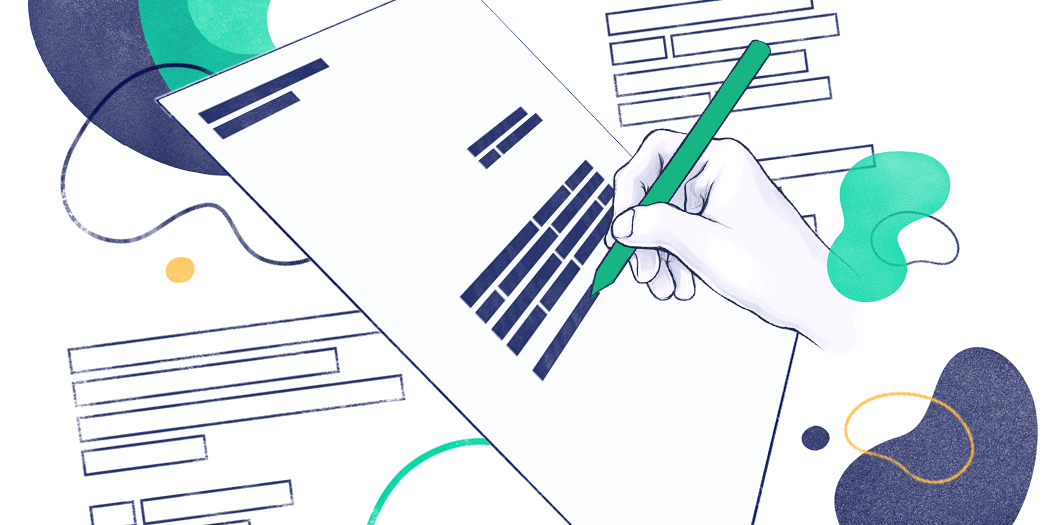
What to Include in a Cover Letter: A Full Guide for 2024
There’s a lot you want to say to convince your future employer to hire you. But before you start writing, learn what to include in a cover letter with our expert guide.

Mariusz Wawrzyniak
Career Expert

33+ Cover Letter Tips and Advice to Stand Out in 2024
Looking for cover letter tips and advice to really stand out? Want cover letter mistakes to avoid and other dos and don'ts? You've come to the right place.

Christian Eilers, CPRW
![cover letter format heading 20+ Modern Resume Templates [Examples for 2024]](https://cdn-images.resumelab.com/pages/modern_templates_listing.jpg)
20+ Modern Resume Templates [Examples for 2024]
You’ve just come across a modern resume template treasure trove. Now, take your time, look around, pick the modern resume you like most, and make a job-winning resume.

Is a Cover Letter Necessary in 2024?
Published: April 03, 2024
Writing a cover letter can be daunting.

I’ll never forget my college career coach, who made writing a cover letter look easy. Even with her tips, I’ve always found it incredibly difficult to talk about myself and hype up my accomplishments.
While it acts as a letter of introduction, I’ve wondered if a cover letter is necessary in 2024. To find out, I spoke with two recruiters and gained insights on how to write the best cover letter for any job application.
![cover letter format heading → Click here to access 5 free cover letter templates [Free Download]](https://no-cache.hubspot.com/cta/default/53/3f347702-d7e9-4e59-9fe4-be4cd7bad191.png)
How important is a cover letter?
Is a cover letter necessary, when to skip a cover letter, when to include a cover letter, tips for writing a cover letter, what if the cover letter is optional.
Cover letters are short letters of introduction that you include with job applications.
Typically, they are your chance to go into deeper details about your accomplishments that you might not have highlighted or had room to mention on your resume.
Tiffany Hall, a professional resume writer and founder of Resume911 , says cover letters are an important part of the job application process.
Hall says, “Cover letters can be very important. It’s supposed to sell why you, of all applicants, should get the job. The issue is that applicants use them to regurgitate what’s on their resume, and that’s not what it’s for. It should speak to what isn’t easily explained with your resume.”
.png)
5 Free Cover Letter Templates
Five fill-in-the-blank cover letter templates to help you impress recruiters.
- Standard Cover Letter Template
- Entry-Level Cover Letter Template
- Data-Driven Cover Letter Template
You're all set!
Click this link to access this resource at any time.
For example, if your resume says you’re skilled at building web pages, your cover letter is a great place to name-drop companies that you’ve worked for to create their websites.
Matthew Muehleisen, a corporate recruiter , thinks a cover letter is also a great place to show you’ve done your homework and researched a company.
Muehleisen says, “It can be what sets you apart from other candidates and applicants and is a good opportunity to show that you’ve done research on the position and company to further showcase your interest in the role.”
Knowing the importance of a cover letter still begs the question: Is a cover letter necessary in 2024?

Image Source
While a cover letter can help demonstrate your knowledge of the company you’re applying to and highlight more of your achievements, both Hall and Muehleisen agree that a cover letter isn’t entirely necessary.
Muehleisen says, “Unless it’s a requirement of the application, I wouldn’t say it’s necessary to include a cover letter. There are some roles (usually in content creation and marketing) that will ask for a cover letter as a form of a writing sample. In these instances, make sure your letter is polished and focused.”
If Hall had her way, she would eliminate the cover letter entirely, focus more on the resume, and ask for a link to an applicant’s LinkedIn profile.
According to Hall, “Most cover letters either repeat the resume or they speak to why the applicant isn’t a good fit. Neither is the purpose of a cover letter.”
Nevertheless, 74% of hiring managers still prefer applications to include a cover letter. So, it is definitely worth considering including one — even if the application says it’s optional.

If you’re looking for a new role, writing a cover letter can be time-consuming — especially if you take the time to personalize every letter you send to a hiring manager.
Although a cover letter does serve a legitimate purpose, and 83% of hiring managers read it, there are a few situations where you shouldn’t include a cover letter. Let’s take a look at those scenarios.
If You Only Have a Template of a Cover Letter
I get it. Writing an effective cover letter takes a significant amount of time.
But consider not sending one if you only have time to plug your information into a cover letter template without personalizing it before hitting submit on an application.
Don’t get me wrong. A cover letter template is a great starting point to write your cover letter. Templates often remind you to include pertinent information like the hiring manager’s title, name, and your contact information.
However, if you don’t take the time to edit the body of the cover letter and personalize it with research and your relevant experience, you risk sending the same letter as another candidate.
And considering that 48% of hiring managers spend anywhere from 30 seconds to two full minutes reading each cover letter, the chances are high that your hiring manager can spot a form letter a mile away.
Don’t send it if you don’t have the time to personalize a cover letter.
If Your Cover Letter Is Full of Critique
A cover letter is meant to explain why you’re the best candidate for the open position. However, a cover letter is not a place for you to share your ideas of how the company can improve.
Sure, every company likely has areas of improvement, and the job you’re applying for might be the role that gets a say in that, but a list of improvements might read as a critique.
You don’t want to potentially offend a hiring manager before you even get an interview. A bad cover letter can hurt a strong candidate, according to 33% of hiring managers .
Before you submit your cover letter, read through it several times to make sure it’s not a critique. If it does sound like a critique, throw it out.
If It’s Not Required
There are other instances where you shouldn’t send a cover letter. For example, if the application’s instructions specifically state that you do not need to submit a cover letter for consideration for the job.
In fact, sending a cover letter anyway can signal to the hiring manager that you don’t follow instructions. Not following instructions is also a great way to land your application in the trash bin.
The bottom line is this: If the application specifically states not to send a cover letter, don’t send it.
Of hiring managers, 74% prefer to see job applications with a cover letter apart from the resume. Knowing this, if you have the time to include a cover letter with your job application, don’t skip it.
Here are three instances when you should send a cover letter with your application.
Send a cover letter if you’re very interested in the role.
Think of your cover letter as your time to shine. Use it as a place to highlight your experiences and the qualifications that make you a great fit for the position.
Hall says, “If you can speak to why you’re a good candidate without copying your resume in paragraph form, include a cover letter.”
In other words, don’t use bullet points in your cover letter to describe your previous employment history.
Instead, talk about what you learned on the job and how your skills will help you excel in the role you’re applying for.
Send a cover letter when there’s a gap in your resume or you’re transitioning industries.
If you’re looking to transition to another industry, you should definitely include a cover letter with your application.
Speaking from personal experience, if I had only submitted a resume to my school district when I applied to be a Spanish teacher, the hiring manager would have just seen my experience in Public Health and would not have known about my skills and success in tutoring students in Spanish.
Muehleisen puts it this way, “If you’re looking to transition to a new industry or if there is a position and company you’re really excited about pursuing as an opportunity, these are the best instances to include a cover letter so that you can possibly give yourself an advantage.”
A cover letter can also help explain any gaps in your resume — especially if the gap in your employment history is beneficial to the role you’re applying for.
For example, maybe you volunteered in South America, and the role you’re applying for is for a position in Global Operations.
It never hurts to include positive, pertinent information in your cover letter.
Send a cover letter when it’s required.
The most obvious time to include a cover letter with your application is when it is required. Just like not including a cover letter when it’s not required, it shows you can follow directions.
Include a cover letter when the application asks you to submit one, which shows you can follow directions.
Plus, if the application asks for a cover letter, you can bet the hiring manager will look for it. If no cover letter is included, well, you’re sabotaging your chances of getting an interview.
Only 13% of hiring managers will consider giving a candidate an interview if they don’t attach a required cover letter to an application.

Writing a cover letter is not as painful as it sounds. There are great templates you can use as a starting point for your cover letter.
The trick with a template, though, is to make sure you always personalize the letter to your own experiences and qualifications.
Here are five expert tips to write a winning cover letter.
1. Tailor your cover letter to the job description.
When writing a cover letter, especially if you use a cover letter template, you should tailor the letter to match the job description and meet the requirements of the application.
For example, if the application asks you to attach a short cover letter, keep it brief. Your best bet is one to two short paragraphs detailing why you’re a great fit for the position.
You’ll also want to reference keywords from the job description in your cover letter. Many recruiters use applicant tracking systems that scan application packets for the best fit.
Often, hiring managers review the applications that match the keywords first.
Now, that doesn’t mean to stuff your cover letter with keywords. Instead, use them in a natural way as you discuss your qualifications.
2. Be personable with your greeting.
You might have seen the advice telling you to use “To Whom It May Concern” instead of the hiring manager’s name. This is good advice, but only if you do not know the hiring manager.
Before resorting to a generic greeting to start your cover letter, take the time to look on the company’s website and LinkedIn to find out who makes hiring decisions.
If you have contacts in your network who are familiar with the company, ask them. Taking the time to research the hiring manager and the company shows you care about the details — a quality many hiring managers look for in a candidate!
If you’re still unsure after researching the company, consider using “Dear Sir or Madam” as your greeting.
3. Be yourself.
While a cover letter is a formal introduction of yourself to a potential employer, it doesn’t need to be lacking in personality. Hall suggests sprinkling your personality in your cover letter to spark connections with the hiring manager.
Hall says, “Be your best professional self. I’m a foodie and will include references to food on my LinkedIn, and I’ve done it in a cover letter. I’ve had managers reference them, and we had a chuckle. I am also very clear about aligning myself with companies whose mission and goals I respect and can contribute to. I make sure to speak to that in the cover letter.”
Take Hall’s advice. Showcasing your vibrant personality in your cover letter can help break the ice in your interview!
4. Proofread your cover letter.
Once you’ve written your cover letter and before you hit “send,” double-check that it is free from spelling and grammar errors and that the company you referenced is the company you are applying to.
Muehleisen says skipping proofreading your cover letter is a big mistake — and it could cost you the job!
Muehleisen says, “Make sure that you are proofreading prior to sending. If the cover letter feels like it is a simple cut/paste or if the job title and company name are incorrect, it may do more harm than good. So, be sure that what you’re sending is pertinent.”
5. Be cautious of AI.
AI tools, like ChatGPT or Claude, are great for helping draft content. You might be tempted to ask generative AI to write your cover letter for you. However, both Hall and Muehleisen say to proceed with caution when it comes to AI.
Hall says, “AI is coming along in amazing ways, so it may come as a surprise that my best tip didn’t include AI. I tell my clients when they’re stuck to look to their peers. You can search people by job title on LinkedIn. See how they describe themselves and pull from there. Or, hire a resume writer or career strategist to help you.”
Muehleisen agrees with her. He says, “I would hesitate to use a tool or service for a cover letter as the point should be to show your authenticity. If you are going to use AI for assistance, make sure to put your own words in as well.”
However, when you write your cover letter, whether using a template or generative AI, personalizing it is key to standing out from the competition.
If the job description says a cover letter is optional, should you send one, or can you get by without it?
That can be tricky, considering 72% of recruiters still expect a cover, even if it’s optional.
According to Muehleisen, sending a cover letter is not a bad idea. He says, “I’ve never heard of a cover letter hurting an applicant’s chances; just make sure the one you’re including is specific to the job description and posting.”
Check out these cover letter examples for more inspiration.
Experiment With Your Cover Letters
Writing a cover letter is a breeze once you get the hang of it. With today’s challenging job market, sending a cover letter with your application can make a difference in whether you get called for an interview.
I can’t make promises that your cover letter will dazzle hiring managers each time, but for the right position for you, it will.
Remember Hall and Muehleisen’s advice when you craft your cover letter. Personalization is key to success!

Don't forget to share this post!
Related articles.

The 23 Best Cover Letter Examples: What They Got Right
![cover letter format heading How to Write a Cover Letter for an Internship [Examples & Template]](https://blog.hubspot.com/hubfs/Copy%20of%20Featured%20Image%20Template%20Backgrounds-Aug-21-2023-02-03-52-3390-PM.png)
How to Write a Cover Letter for an Internship [Examples & Template]
![cover letter format heading Letter of Interest Tips, Templates & Examples [A 2023 Guide]](https://blog.hubspot.com/hubfs/letter%20of%20interest.png)
Letter of Interest Tips, Templates & Examples [A 2023 Guide]

15 Cover Letter Templates to Perfect Your Next Job Application

The Ultimate Guide to Writing a Cover Letter
![cover letter format heading How to Start a Cover Letter to Impress Employers [+ 14 Examples]](https://blog.hubspot.com/hubfs/how-to-start-a-cover-letter.jpg)
How to Start a Cover Letter to Impress Employers [+ 14 Examples]

Eight Cover Letter Greetings for Every Situation

7 Expert Cover Letter Tips to Get the Job
Marketing software that helps you drive revenue, save time and resources, and measure and optimize your investments — all on one easy-to-use platform

IMAGES
VIDEO
COMMENTS
Cover letter heading template. If you want a no frills cover letter template, you could copy and paste our template below—we won't tell anyone. (If your cover letter is going into an email, just paste this at the end rather than the beginning.) Feel free to play with the formatting—for example, by making your name larger, combining some ...
Whether your tool of choice is Microsoft Word or Google Docs, here's how to create a cover letter heading: Open a blank document in either Microsoft Word or Google Docs. Set margins to be 1" on all sides of your document (usually the default). Set line spacing to be 1.00 or 1.15 (also usually the default setting).
If you're providing a hard copy of your cover letter, handwrite your signature and also include your full typed name. Download Cover Letter Outline Template. To upload the template into Google Docs, go to File > Open > and select the correct downloaded file. Related: Creating the Perfect Cover Letter (With Template and Example)
If you decide to put your address on your cover letter header, write your full mailing address. Here's an example of an applicant's mailing address on their header: 1444 Burton Avenue, Memphis, TN 38117. Alternatively, you can write down only your city and state, like this: Memphis, TN.
Proper Cover Letter Heading Format: Two Main Rules. Actually, all you need to know is this—. 1. What to include in the cover letter header: Your full name. Your job title (optional) Home address (optional) Phone number. Email address.
Here's a breakdown of how a cover letter should be structured: 1. Add your name and contact information to the header. At the top of your cover letter, include the following information: Name: Your full name should be the focal point of your cover letter's header, so use a large font size and bold text. Phone number.
2. Include a greeting. In your research, try to find the name of the person reviewing applications for the job. Address your letter to this person with a common business greeting, such as "Dear [first and last name]" or "Dear [position title]." Avoid using "To whom it may concern."
A cover letter format follows a straightforward business letter format. Use 1-inch margins with a common font like Helvetica in 12-point size for maximum legibility. Align the date and hiring manager's address at the top left under the cover letter heading.
Portland, OR 45720. 890-372-1262. [email protected]. February 2, 2005. Amy Kincaid, Human Resource Director. Western Electric, Inc. 387 Collier Lane. Atlanta, Georgia 30051. Job seekers at Purdue University may find value in the Purdue career Wiki here.
Papadopoulos suggests decreasing the header space first. Alignment: All your text should be left aligned and there's no need to indent every paragraph. Line spacing: Single space your cover letter (1.15 spacing works if it looks too cramped). Include an extra line between each section and paragraph.
You can follow these steps to draft an appropriate cover letter header for your next application: 1. Choose a format. The format and style of a cover letter header can visually attract a hiring manager's attention to an application. You can format your heading by listing all information line after line.
The layout of a cover letter contains six basic elements: the header, the salutation or greeting, the introduction paragraph, the body of the letter, the closing paragraph and the signoff. These sections should always appear in the same order on every letter you write. For more information on the layout of a cover letter, visit our How to Write ...
Example 10: Eye-catching Heading. An eye-catching heading uses a bold font, color, or unique design to catch the reader's attention and make a lasting impression. It's a great option for creative fields. Your cover letter heading should be a reflection of your personal style and the job you're applying for.
In a nutshell, this is how to format a cover letter: Use one-inch margins, single line spacing, and 11 to 12-pt font. In the top-left corner, put your contact details, city and date, and the employer's contact details. Open with a personal salutation.
Check out our guide on how to start a cover letter effectively! #4. Cover Letter Body. The body of your cover letter usually consists of 1-3 paragraphs and is where you convince the recruiter that you're the right person for the job. We have a few pointers to help you do that: Don't just rehash your CV.
It's 2022, and you'll most likely be submitting your cover letter to the company's hiring software platform, or by email. If so, simply type out your first and last name, leaving some spacing under the closing. Alternatively, you can use a signature generator to add an e-signature at the bottom of the document.
3 example cover letter headings. Here are three cover letter header examples (if you like them, you can download the entire cover letter templates that go with them for free): 1. Basic cover letter header. Download Free Header Template. You can use this cover letter heading to apply for any role at any company.
Use 1.15 line spacing throughout and insert a blank line between each paragraph. Format your cover letter as a PDF. Name your cover letter file with your first name, last name, the words "cover letter," and the job title or company name. Keep your letter within 250 to 400 words and less than one page.
Cover Letter Format: Examples You Can Copy and Use. How to Start a Cover Letter—Introduction, 20 Examples. 1. Sample Cover Letter Header Template. To start things off, here's a simple cover letter heading for you to reference or copy-paste into your job application: [Your First and Last Name]
A cover letter should include the following parts: Header. Salutation. Introduction. Body paragraph. Closing paragraph. Letter ending and signature. The following cover letter samples and examples will show you how to write a cover letter for many employment circumstances. Browse cover letters by job title for inspiration.
Close with a summary of your top qualifications and finish with a compelling call to action. Cover letter closing paragraph example: "My content and UX writing skills and SEO experience make me an ideal candidate for this position. I look forward to hearing from you to discuss how I can be an asset to the team.".
GOOD EXAMPLE. Dear Mr. Jones / Dear Ms. Jones, Dear Alex Jones, Dear Alex, Pick the first variant ( Dear Mr. / Ms. Lastname) if you're formatting a cover letter for a federal job or any other position with a formal work environment. Most business cover letters for corporate positions fall under this category, too.
9. Format the margins properly. The ideal margin size for a cover letter is 1 inch all around. Set the right and left margins at 1 inch and the top and bottom margins at 1 inch as well. This makes your cover letter look clean and uncluttered. It also provides lots of white space, which helps increase readability.
Published: April 03, 2024. Writing a cover letter can be daunting. I'll never forget my college career coach, who made writing a cover letter look easy. Even with her tips, I've always found it incredibly difficult to talk about myself and hype up my accomplishments. While it acts as a letter of introduction, I've wondered if a cover ...